Sun Jun 28, 2015
You are invited to join Collapse Dialogue #2 on Monday, June 29th from 6 ~ 9 pm
I have been collaborating with artist/activist Lydia Eccles who has introduced me to thinking about climate disruption in a new way.
Thought is never just thought, It’s also the bodily state, the feeling, the nerves. It connects with everything else.
It’s not merely intellectual activity. And it passes between people. It’s all one process all over the world.
David Bohm ~ Thought As A System
COLLAPSE DIALOGUE is an embodied, face-to-face experiment in conscious observation of our collective
system of thought as it relates to social-environmental collapse. Investigative principles of insight meditation
are applied to our collective expression to allow us to perceive incoherance caused by individual and cultural
conditioning, and other inherent flaws in thought itself. The Dialogue is free of any agenda; we are not trying to
reach conclusions, find concensus, plan action or learn the latest figures about climate disruption. Everything is
allowed. Habits of persuasion, debate and self-censorship are to be abandoned. We aim to develop the ability
to suspend our beliefs and judgments to listen with full ‘selfless’ attention to others, and more especially, to
our own reactivity as it arises: thoughts, emotions, feelings, body sensations... Hidden assumptions emerge
through friction between us, producing discomfort that we affirmatively choose to sustain rather than escape,
so we can see into presuppositions, ideas and beliefs that subtly control our interactions and reveal puzzling
patterns of fragmentation, repression, avoidance, denial, conflict. Our agreement to carefully lower instinctive
ego defenses, to speak truly and spontaneously, opens a free flow of meaning between us.
Physicist David Bohm and philospher Krishnamurti addressed systematic faults in thought, and saw
them as the root cause of global incoherence. Bohm conceived of Dialogue as a way to ‘see through’ thought,
yet he never specifically defined a process.
We will create a template based on our 5-session experiment.
Sunday, July 19, 2015
ACES TOO HIGH : Margaret Bellafiore
Tue Feb 24, 2015
Cissy White and I have been collaborating on an upcoming workshop (March 15, 2015) at Mobius on the ACE SCORE, a test to measure adverse childhood experiences. White recently had her article, Weathered by My High ACE Score,selected for the home page of the website Acestoohigh.com
Read it here:
http://acestoohigh.com/2015/02/22/weathered-by-my-high-ace-score/
Cissy White and I have been collaborating on an upcoming workshop (March 15, 2015) at Mobius on the ACE SCORE, a test to measure adverse childhood experiences. White recently had her article, Weathered by My High ACE Score,selected for the home page of the website Acestoohigh.com
Read it here:
http://acestoohigh.com/2015/02/22/weathered-by-my-high-ace-score/
David Miller, a former member of the Mobius Artists Group, is launching his new (and first!) chapbook, The Afterimages : Joanne Rice
Mon Sep 29, 2014
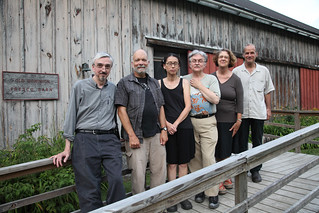
Thought you might be interested in learning that David Miller, a former member of the Mobius Artists Group, is launching his new (and first!) chapbook, The Afterimages, published by Cervena Barva Press on Saturday, October 4 at 2pm.
Cervena Barva Press Studio, is located at the Arts at the Armory
Building, 191 Highland Avenue, Somerville - room B8 (basement).
He will be reading with Lee Varon and M.p. Carver
Mobius friend, Jane Wiley did the cover art.
If you cannot make the launch on October 4, perhaps you can see David on October 11.
He will be reading as
part of the Mr. Hip Presents series in Jamaica Plain.
That event is from
6-8:30 pm. Here's the link:
http://www.mrhippresents.com/events/2014/10/11/mr-hip-presents-october-reading.
The UForge Gallery's site is here: http://www.uforgegallery.com/ .
photo credit: Variations 8 (by John Cage) at Skowhegan. Produced by David Miller. Participating artists include, in this photo, L-R: Bob Raymond, Larry Johnson, Jane Wang, David Miller, Margaret Bellafiore, Jed Speare. At the Skowhegan School of Painting and Scuplture. 8/6/11. Photo by Marilyn Arsem.

Thought you might be interested in learning that David Miller, a former member of the Mobius Artists Group, is launching his new (and first!) chapbook, The Afterimages, published by Cervena Barva Press on Saturday, October 4 at 2pm.
Cervena Barva Press Studio, is located at the Arts at the Armory
Building, 191 Highland Avenue, Somerville - room B8 (basement).
He will be reading with Lee Varon and M.p. Carver
Mobius friend, Jane Wiley did the cover art.
If you cannot make the launch on October 4, perhaps you can see David on October 11.
He will be reading as
part of the Mr. Hip Presents series in Jamaica Plain.
That event is from
6-8:30 pm. Here's the link:
http://www.mrhippresents.com/events/2014/10/11/mr-hip-presents-october-reading.
The UForge Gallery's site is here: http://www.uforgegallery.com/ .
photo credit: Variations 8 (by John Cage) at Skowhegan. Produced by David Miller. Participating artists include, in this photo, L-R: Bob Raymond, Larry Johnson, Jane Wang, David Miller, Margaret Bellafiore, Jed Speare. At the Skowhegan School of Painting and Scuplture. 8/6/11. Photo by Marilyn Arsem.
Labels:
David Miller
Mobius/808 Infuse-Yuka Takahashi + Angela Sawyer @ the Fund-Raiser Event - June 14 : 808.Mobius.Infuse.
Tue Jun 03, 2014
Mobius/808 Infuse
Yuka Takahashi + Angela Sawyer @ the Fund-Raiser Event - June 14
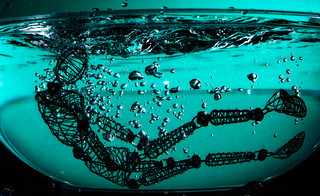
Sinking Adam
Yuka Takahashi + Angela Sawyer
Walking through life, our actions and beliefs are often judged by other people with their own unique perspectives. How much does the fear of being judged influence our own actions and, on the other hand, how does the way we deal with this fear influence the judgment? There is an almost physical quality to the vibe given by judging eyes.
Do invisible vibrations in the air change a person's body? Can a body change the signals those invisible vibrations give off?
Yuka Takahashi and Angela Sawyer work in somatic movement & sound respectively, but they both cross back & forth between conceptual composition and improvisation. Their collaboration blends their separate arts in unique ways.

Yuka Takahashi
Yuka Takahashi is a dancer, performer, improviser and choreographer currently based in Boston. She is originally from Japan. Her works are highly influenced by conceptual /experimental practice and movement invention. Her experimental approach towards her creations are by actively making an attempt to employ various media and taking advantage of the specific performance site to expand the possibility of presenting the concept from many perspectives without forgetting the existence of the body. At the same time she is interested in taking the audience out of its passive role and actively engage it in the performance.
After she received professional training at Joffrey Ballet School, she extended her interest and training in dance and performance art in NYC and Europe. In 2006 she moved to Vienna, Austria. There, she received a residency at D.ID curated by Liz King and she was an artist in residence at the experimental performance LAB called LABfactory for 2 years. At LABfactory she regularly created inter-disciplinary productions with full professional support under the direction of Thomas J. Jelinek and Kazuko Kurosaki. Since she was in Vienna, she has been strongly engaged with artists of other disciplines. Her works and collaboration projects were performed around Europe, Japan and the United States. Since moving to Boston in May 2011 she has presented her own works at Mobius, Boston Center for the Arts, Boston University, Movement Research (NYC), Y Theater at YMCA and OBERON. She produced the experimental performance events 'Living Space' at OBERON (2012) and 'Test Kitchen' at Cambridge Y (2014).
Web: www.highbridgeproject.com

Angela Sawyer
After finishing a philosophy degree specialising in Husserlian phenomenology in the mid-1990s, writer and musician Angela Sawyer felt fully prepared to start astonishing audiences around the Boston area using her mouth, some broken electronics, toys & noisemakers. Impromptu squealing & gargling has become her specialty, and she’s released a steady trickle of small-run lps, cds, cdrs & cassettes over the years. She changes the names of her projects to suit her every whim, but longer running ones include Preggy Peggy & the Lazy Babymakers and Duck That. Her 2014 lp release “A Short Visit To The City That Bleeds” is full of weird up-close intimate wordage and environmental activity recorded in and around a rental car parked in Baltimore, MD. Dennis Tyfus from the Ultra Eczema label says Sawyer is “the best living vocal artist”. You can also catch Angela doing stand up comedy around town, & she runs the one & only Weirdo Records from a tiny storefront in Central Square Cambridge.
Web: www.weirdorecords.com
Mobius/808 Infuse
Yuka Takahashi + Angela Sawyer @ the Fund-Raiser Event - June 14

Sinking Adam
Yuka Takahashi + Angela Sawyer
Walking through life, our actions and beliefs are often judged by other people with their own unique perspectives. How much does the fear of being judged influence our own actions and, on the other hand, how does the way we deal with this fear influence the judgment? There is an almost physical quality to the vibe given by judging eyes.
Do invisible vibrations in the air change a person's body? Can a body change the signals those invisible vibrations give off?
Yuka Takahashi and Angela Sawyer work in somatic movement & sound respectively, but they both cross back & forth between conceptual composition and improvisation. Their collaboration blends their separate arts in unique ways.

Yuka Takahashi
Yuka Takahashi is a dancer, performer, improviser and choreographer currently based in Boston. She is originally from Japan. Her works are highly influenced by conceptual /experimental practice and movement invention. Her experimental approach towards her creations are by actively making an attempt to employ various media and taking advantage of the specific performance site to expand the possibility of presenting the concept from many perspectives without forgetting the existence of the body. At the same time she is interested in taking the audience out of its passive role and actively engage it in the performance.
After she received professional training at Joffrey Ballet School, she extended her interest and training in dance and performance art in NYC and Europe. In 2006 she moved to Vienna, Austria. There, she received a residency at D.ID curated by Liz King and she was an artist in residence at the experimental performance LAB called LABfactory for 2 years. At LABfactory she regularly created inter-disciplinary productions with full professional support under the direction of Thomas J. Jelinek and Kazuko Kurosaki. Since she was in Vienna, she has been strongly engaged with artists of other disciplines. Her works and collaboration projects were performed around Europe, Japan and the United States. Since moving to Boston in May 2011 she has presented her own works at Mobius, Boston Center for the Arts, Boston University, Movement Research (NYC), Y Theater at YMCA and OBERON. She produced the experimental performance events 'Living Space' at OBERON (2012) and 'Test Kitchen' at Cambridge Y (2014).
Web: www.highbridgeproject.com

Angela Sawyer
After finishing a philosophy degree specialising in Husserlian phenomenology in the mid-1990s, writer and musician Angela Sawyer felt fully prepared to start astonishing audiences around the Boston area using her mouth, some broken electronics, toys & noisemakers. Impromptu squealing & gargling has become her specialty, and she’s released a steady trickle of small-run lps, cds, cdrs & cassettes over the years. She changes the names of her projects to suit her every whim, but longer running ones include Preggy Peggy & the Lazy Babymakers and Duck That. Her 2014 lp release “A Short Visit To The City That Bleeds” is full of weird up-close intimate wordage and environmental activity recorded in and around a rental car parked in Baltimore, MD. Dennis Tyfus from the Ultra Eczema label says Sawyer is “the best living vocal artist”. You can also catch Angela doing stand up comedy around town, & she runs the one & only Weirdo Records from a tiny storefront in Central Square Cambridge.
Web: www.weirdorecords.com
Jan Świdziński, Polish artist, performer, philosopher and art critic : Joanne Rice
Thu Feb 20, 2014
On Sunday (Feb. 9, 2014) Jan Świdziński died.
He was a Polish artist, performer, philosopher and art critic.
He was very inspirational.
My condolences to his family, and the art community in Poland.
Joanne Rice

Pictured: Lewis Gesner, Kristina Lenzi, Jan Świdziński, International Festival, In the Context: of Art / DIFFERENCES, Warsaw, Poland (2006)
On Sunday (Feb. 9, 2014) Jan Świdziński died.
He was a Polish artist, performer, philosopher and art critic.
He was very inspirational.
My condolences to his family, and the art community in Poland.
Joanne Rice

Pictured: Lewis Gesner, Kristina Lenzi, Jan Świdziński, International Festival, In the Context: of Art / DIFFERENCES, Warsaw, Poland (2006)
Labels:
Joanne Rice
Documentation from An Un-interpreted Experience V2.0 (Just another day) : Aaron Lish
Wed Aug 07, 2013
Text extracted from Aaron Lish's blog:
http://uninterpretedexperiencev2.blogspot.com/
On January 19th, 2013 five participants and myself went for a walk in the woods at night just north of Boston. We played a compass game that had each of the participants walking solo through the dark, waiting in the woods for the whistle, and then returning. This was repeated three times, with each wait becoming longer and longer; the first interval lasted approximately 1 minute, the second interval was 5 minutes, and the last interval lasted 20 minutes.
During the time in the woods participants meditated on the following koans.
-As we walked into the woods, and while playing the compass game:
“THE FIRST IS LIKE A MASSIVE PENDULUM OF IRON THAT SWINGS BACK AND FORTH, BACK AND FORTH, BACK AND FORTH. THE SECOND SQUIRMS AND WRIGGLES LIKE A BLUEFISH IN THE BAY.”
-And as we walked back from the woods:
“MU, WHY DID I KID MYSELF THAT THE FIRST TIME HAS ABOSLUTELY NOTHING TO DO WITH LIFE; THE FIRST, THE SECOND, AND EVERY OTHER TIME HAS ABSOLUTELY EVERYTHING AND ABSOLUTELY NOTHING TO DO WITH MY LIFE. THAT IS WHY I ENJOY IT AND HATE IT AT THE SAME TIME.”
We then sat on the floor of the Oak Grove T-station (which was closed for construction) and engaged in dialogue. The discussion started with how the compass game in the dark could relate to the koans, and how any of the experiences or thoughts had in the woods could relate to daily life. From there the conversation "drifted" to various things, including sharing childhood memories.
The project was designed to indirectly analyze our society and culture through a camouflaged look at our daily patterns.
Note: I intentionally do not include documentation of the dialogue as there is no way to represent the experiences had by the participants. As James Turrell says of his work, this is a "non-vicarious art". Unlike with reality TV, you can't have a secondary experience by listening in on the conversations that happened in the subway stop in Melrose.
- Aaron Lish
Related Mobius Event Page: http://www.mobius.org/events/un-interpreted-experience-version-20
Text extracted from Aaron Lish's blog:
http://uninterpretedexperiencev2.blogspot.com/
On January 19th, 2013 five participants and myself went for a walk in the woods at night just north of Boston. We played a compass game that had each of the participants walking solo through the dark, waiting in the woods for the whistle, and then returning. This was repeated three times, with each wait becoming longer and longer; the first interval lasted approximately 1 minute, the second interval was 5 minutes, and the last interval lasted 20 minutes.
During the time in the woods participants meditated on the following koans.
-As we walked into the woods, and while playing the compass game:
“THE FIRST IS LIKE A MASSIVE PENDULUM OF IRON THAT SWINGS BACK AND FORTH, BACK AND FORTH, BACK AND FORTH. THE SECOND SQUIRMS AND WRIGGLES LIKE A BLUEFISH IN THE BAY.”
-And as we walked back from the woods:
“MU, WHY DID I KID MYSELF THAT THE FIRST TIME HAS ABOSLUTELY NOTHING TO DO WITH LIFE; THE FIRST, THE SECOND, AND EVERY OTHER TIME HAS ABSOLUTELY EVERYTHING AND ABSOLUTELY NOTHING TO DO WITH MY LIFE. THAT IS WHY I ENJOY IT AND HATE IT AT THE SAME TIME.”
We then sat on the floor of the Oak Grove T-station (which was closed for construction) and engaged in dialogue. The discussion started with how the compass game in the dark could relate to the koans, and how any of the experiences or thoughts had in the woods could relate to daily life. From there the conversation "drifted" to various things, including sharing childhood memories.
The project was designed to indirectly analyze our society and culture through a camouflaged look at our daily patterns.
Note: I intentionally do not include documentation of the dialogue as there is no way to represent the experiences had by the participants. As James Turrell says of his work, this is a "non-vicarious art". Unlike with reality TV, you can't have a secondary experience by listening in on the conversations that happened in the subway stop in Melrose.
- Aaron Lish
Related Mobius Event Page: http://www.mobius.org/events/un-interpreted-experience-version-20
Labels:
Aaron Lish
EncycloMedia Installation, Notes on how to install Paper Screens for Video Projection : Terra Friedrichs
Mon Jan 07, 2013
To be able to use the Mobius space for my video projection art, I needed white walls. The black walls could be used if I were to project "over" a band, or other performance. But to showcase the projections clearly, I wanted white walls. So I had to decide...do I paint? or paper. A classic home improvement project!
Anyway, to paint would have shaved off several days of the time I had to show, so I decided to paper. The cost benefit was not that much different, as it turns out. I used 5' wide "banner paper" and installed one side with gaffe tape, and the overlapping side with double sticky carpet tape. The trick, as it turns out was to make sure to "smooth" the paper out BEFORE sticking. This is obvious. But it's not obvious "how" to do it.
I'm making note of this, because I searched far and wide online to find out how to create large scale paper screens on walls, and could only find how to make small screens.
So I'll continue.
Supplies: 3.5 rolls of white gaffe tape (professional gaffe tape, not the cheap kind in the hardware stores). You can get it at stage hand stores, like the Backstage Store in Boston. 2 x 55 yard rolls of 5' banner paper. white upholstery tacks (not sure how many...maybe 50?). I investigated several types of paper, and decided on the banner paper, because it was widely available, affordable, and came in different sizes (in case I could get away with not using the whole 2 rolls). I also wanted to experiment with using the banner paper on the windows and "rear projecting" onto the paper, so that people outside the gallery could see the projections on the paper. As it turned out, because the banner paper worked so well, there was no reason to project onto the windows. Because people on the street could see the projections on the far walls. So I took the window paper down. For future refernece, if you do not have the luxury of projecting onto far walls, you might like to use tracing paper, which gives an eerie effect and allows cheaper projectors to be used...less crips projections aren't as neceesary to get through the thicker banner paper.
Anyway, on to the installation of the banner paper to make the walls into a huge screen.
The paper was applied in "columns"...from top to bottom of the wall, with each "column" being right next to each other, overlapping a couple of inches. On the first column, BOTH sides of the paper were gaffe taped to the wall. On subsequent papers, only nne side of the paper columns was gaffe taped to the wall. The the other side was overlapped onto the first column and carpet taped to the first column. More detailed instructions follow.
Step 1, unroll the paper on the part of the wall you want papered. We used a large step ladder and left the roll of paper on the floor, and pulled the edge of the paper up as one of us walked up the ladder. This unrolled the paper from the floor on up. If you're doing this, make sure to LEAVE THE ROLL ON THE FLOOR while you get things ready to "stick". The weight of the roll and the tension that the roll places helps keep the paper flat and smooth. In other words, DO NOT CUT the paper, til it's stuck pretty firmly to the wall most of the way down the wall.
Step 2, Once the paper is rolled out along the wall (top to bottom), tape the top using small pieces of tape to tape the paper in place. At this point ONLY USE SMALL PIECES OF TAPE...like 1 inch pieces, because you'll move the paper around a little til you get it lined up with the corner, or the other pieces of paper. Once you are happy that the paper is lined up, THEN tape the entire top of the paper, really good...like maybe two rows of tape. If this is your first "column" of paper, then gaffe BOTH sides nice and firm, two rows of gaffe tape. If it's the next column, then BEFORE pulling up the column from the roll, make sure to put carpet tape onto the nearest side of the previously taped column. But DO NOT PULL OFF THE SECOND SIDE of the tape...or else you'll end up with everything stuck to you, and ruining the second column.
Step 3, install the carpet tape on the nearest side of the first column. Put it ON the gaffe tape, if you feel like you want to preserve the paper after the installation. I hadn't fully decided if it mattered, really, where the carpet tape went, but I felt like it was "more secure" to have it on the paper, rather than on the gaffe tape.
Step 4, roll out the second column, tape it lightly and line it up with the first column MAKING SURE that the paper fully covers the carpet tape BEFORE fully taping down the second column
Step 5, continue til all the walls are covered.
Step 6, hammer in upholstery tacks at the top of each column...maybe one every 1.5 feet
Step 7...enjoy!
To be able to use the Mobius space for my video projection art, I needed white walls. The black walls could be used if I were to project "over" a band, or other performance. But to showcase the projections clearly, I wanted white walls. So I had to decide...do I paint? or paper. A classic home improvement project!
Anyway, to paint would have shaved off several days of the time I had to show, so I decided to paper. The cost benefit was not that much different, as it turns out. I used 5' wide "banner paper" and installed one side with gaffe tape, and the overlapping side with double sticky carpet tape. The trick, as it turns out was to make sure to "smooth" the paper out BEFORE sticking. This is obvious. But it's not obvious "how" to do it.
I'm making note of this, because I searched far and wide online to find out how to create large scale paper screens on walls, and could only find how to make small screens.
So I'll continue.
Supplies: 3.5 rolls of white gaffe tape (professional gaffe tape, not the cheap kind in the hardware stores). You can get it at stage hand stores, like the Backstage Store in Boston. 2 x 55 yard rolls of 5' banner paper. white upholstery tacks (not sure how many...maybe 50?). I investigated several types of paper, and decided on the banner paper, because it was widely available, affordable, and came in different sizes (in case I could get away with not using the whole 2 rolls). I also wanted to experiment with using the banner paper on the windows and "rear projecting" onto the paper, so that people outside the gallery could see the projections on the paper. As it turned out, because the banner paper worked so well, there was no reason to project onto the windows. Because people on the street could see the projections on the far walls. So I took the window paper down. For future refernece, if you do not have the luxury of projecting onto far walls, you might like to use tracing paper, which gives an eerie effect and allows cheaper projectors to be used...less crips projections aren't as neceesary to get through the thicker banner paper.
Anyway, on to the installation of the banner paper to make the walls into a huge screen.
The paper was applied in "columns"...from top to bottom of the wall, with each "column" being right next to each other, overlapping a couple of inches. On the first column, BOTH sides of the paper were gaffe taped to the wall. On subsequent papers, only nne side of the paper columns was gaffe taped to the wall. The the other side was overlapped onto the first column and carpet taped to the first column. More detailed instructions follow.
Step 1, unroll the paper on the part of the wall you want papered. We used a large step ladder and left the roll of paper on the floor, and pulled the edge of the paper up as one of us walked up the ladder. This unrolled the paper from the floor on up. If you're doing this, make sure to LEAVE THE ROLL ON THE FLOOR while you get things ready to "stick". The weight of the roll and the tension that the roll places helps keep the paper flat and smooth. In other words, DO NOT CUT the paper, til it's stuck pretty firmly to the wall most of the way down the wall.
Step 2, Once the paper is rolled out along the wall (top to bottom), tape the top using small pieces of tape to tape the paper in place. At this point ONLY USE SMALL PIECES OF TAPE...like 1 inch pieces, because you'll move the paper around a little til you get it lined up with the corner, or the other pieces of paper. Once you are happy that the paper is lined up, THEN tape the entire top of the paper, really good...like maybe two rows of tape. If this is your first "column" of paper, then gaffe BOTH sides nice and firm, two rows of gaffe tape. If it's the next column, then BEFORE pulling up the column from the roll, make sure to put carpet tape onto the nearest side of the previously taped column. But DO NOT PULL OFF THE SECOND SIDE of the tape...or else you'll end up with everything stuck to you, and ruining the second column.
Step 3, install the carpet tape on the nearest side of the first column. Put it ON the gaffe tape, if you feel like you want to preserve the paper after the installation. I hadn't fully decided if it mattered, really, where the carpet tape went, but I felt like it was "more secure" to have it on the paper, rather than on the gaffe tape.
Step 4, roll out the second column, tape it lightly and line it up with the first column MAKING SURE that the paper fully covers the carpet tape BEFORE fully taping down the second column
Step 5, continue til all the walls are covered.
Step 6, hammer in upholstery tacks at the top of each column...maybe one every 1.5 feet
Step 7...enjoy!
Video Project Art: How it started... : Terra Friedrichs
Sat Dec 08, 2012
The idea for my video project art came to me while I was sitting at a music performance with my eyes closed. I was in a semi-dream state when I turned to my partner to tell of the images I was seeing. I realized that it was easier to film them and show him that to explain verbally. So I set out to figure out how to reconstruct my dreams.
Using projectors stretched along walls, ceilings and floors created a surreal image gallery which felt like a kaleidascope and came close to what I'd been dreaming. So I decided to do a series of these "dream sequences" and now have an "album" of various spaces, themes, and moods that I present either as video projection art in and of itself, or as accompaniment to performers/bands/dancers, etc. Some have referred to me as a VJ, as I change the video clips and/or the direction of the projectors to suit the mood of the room.
When Jane mentioned that the Mobius space would be dark for a few days over the holiday and offered that I could show, I jumped at the chance. I've many pieces in process. But my work in Occupy and the realization of our fragile our earth and societal constructs are, while still being extremely resilient inspired my pulling these pieces together for this run.
I hope you can make it on one of the performance nights, or to just stop by and see what's showing on the other nights.
Have a GREAT HOLIDAY month! Seeya next year, hopefully!
T
The idea for my video project art came to me while I was sitting at a music performance with my eyes closed. I was in a semi-dream state when I turned to my partner to tell of the images I was seeing. I realized that it was easier to film them and show him that to explain verbally. So I set out to figure out how to reconstruct my dreams.
Using projectors stretched along walls, ceilings and floors created a surreal image gallery which felt like a kaleidascope and came close to what I'd been dreaming. So I decided to do a series of these "dream sequences" and now have an "album" of various spaces, themes, and moods that I present either as video projection art in and of itself, or as accompaniment to performers/bands/dancers, etc. Some have referred to me as a VJ, as I change the video clips and/or the direction of the projectors to suit the mood of the room.
When Jane mentioned that the Mobius space would be dark for a few days over the holiday and offered that I could show, I jumped at the chance. I've many pieces in process. But my work in Occupy and the realization of our fragile our earth and societal constructs are, while still being extremely resilient inspired my pulling these pieces together for this run.
I hope you can make it on one of the performance nights, or to just stop by and see what's showing on the other nights.
Have a GREAT HOLIDAY month! Seeya next year, hopefully!
T
A Mouse's Tale - Fun With Fables : Norah Solorzano
Thu Nov 15, 2012
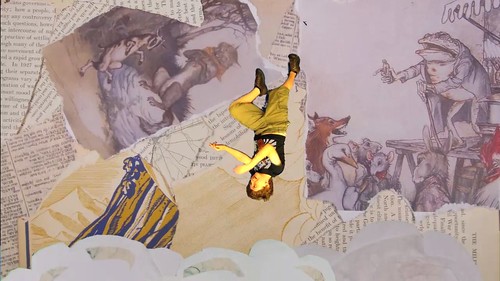
Still image from A Mouse's Tale!, an animation by 5th/6th grade students at Cambridgeport Elementary School
The latest animated movie to come out of the Animating Youth Project at Room 305 Productions was A Mouse's Tale! The movie was finished in June 2012 and marked the end of the Room 305 era, as the Cambridgeport school went through great changes and rearranges over the summer. The completion of A Mouse's Tale! meant we went out with a bang!
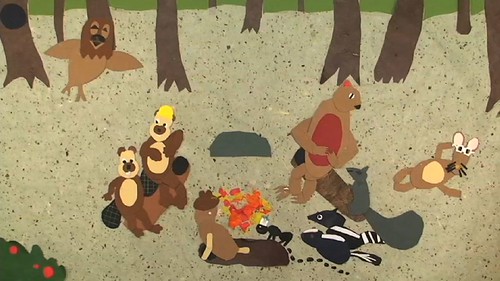
The movie mixes live action and paper cutout animation and tells the story of a classroom in disarray, until one student stumbles into the mysterious world of Fableland and comes to understand the importance of cooperation and teamwork. Isabel Eccles' 5th and 6th graders combined their literacy and social studies with the making of this animated film, creating an original fable story that addressed some of the conflicts they were experiencing in their own classroom. The result is a fun, beautiful, sparkling and inspiring short animated film, a gift to the school on the eve of great changes.
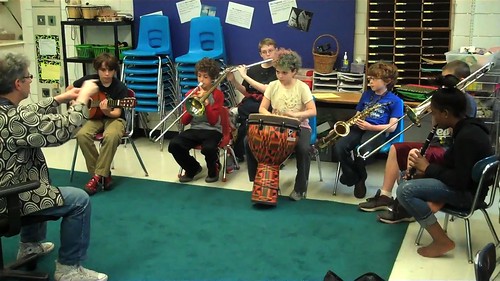
A Mouse's Tale made it's debut at the graduation ceremonies in June 2012 and can be seen as part of the Animating Youth! A Room 305 Retropsective show at Mobius January 19-23, 2013. It will be screened at Mobius along with other selections from the Animating Youth archives at 7pm on January 19th.
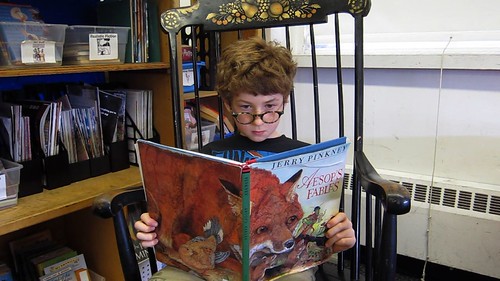

Still image from A Mouse's Tale!, an animation by 5th/6th grade students at Cambridgeport Elementary School
The latest animated movie to come out of the Animating Youth Project at Room 305 Productions was A Mouse's Tale! The movie was finished in June 2012 and marked the end of the Room 305 era, as the Cambridgeport school went through great changes and rearranges over the summer. The completion of A Mouse's Tale! meant we went out with a bang!

The movie mixes live action and paper cutout animation and tells the story of a classroom in disarray, until one student stumbles into the mysterious world of Fableland and comes to understand the importance of cooperation and teamwork. Isabel Eccles' 5th and 6th graders combined their literacy and social studies with the making of this animated film, creating an original fable story that addressed some of the conflicts they were experiencing in their own classroom. The result is a fun, beautiful, sparkling and inspiring short animated film, a gift to the school on the eve of great changes.

A Mouse's Tale made it's debut at the graduation ceremonies in June 2012 and can be seen as part of the Animating Youth! A Room 305 Retropsective show at Mobius January 19-23, 2013. It will be screened at Mobius along with other selections from the Animating Youth archives at 7pm on January 19th.

Happy 100th, John Cage! - notes on Ryoanji : David Miller
Wed Aug 29, 2012
As mentioned in the previous post, on September 5 Tom Plsek and I are celebrating John Cage's 100th birthday with a free concert at the Berklee College of Music Practice Facility on Fordham Road in Allston. All through 2012, there have been concerts and festivals honoring Cage's centenary year, with more to come (see http://johncage.org/2012/events.html). But, as near as we can tell, on the birthday itself, this is the only Cage celebration happening in the Boston area. For fuller information, including directions: http://www.mobius.org/events/happy-100th-john-cage.
The previous post included some thoughts about Two5, a piece from John Cage's late period. We're also doing the later-period work, Ryoanji, in a version for trombone and percussion, as well as the middle-period Solo for Sliding Trombone from the Concert for Piano and Orchestra.
The title Ryoanji designates a set of related compositions for solo instruments or voice in different combinations; there is also a version for orchestra. It is inspired by the famous rock garden at the Ryōan-ji temple in Kyoto, consisting of fifteen rocks in a bed of raked sand. Sure, there’s a decent Wikipedia article about the temple and garden, but for variety: http://www.yamasa.org/japan/english/destinations/kyoto/ryoanji.html. “Put simply, this rock garden is acknowledged to be one of the absolute masterpieces of Japanese culture.”
Cage’s experience of this garden inspired a set of visual works beginning in 1983, featuring the outlines of rocks, and work on the music began afterwards. To produce the solo parts, Cage traced portions of the outlines of a set of stones – these curved line become complex, irregular glissandi. There are places where the contours overlap, creating multiple voices at the same time. The percussion part for Ryoanji remains the same regardless of which combination of solo players perform. It consists of a slow, irregular set of beats on two objects simultaneously – one metal and the other wood. Where the solo parts are inspired by the rocks themselves, the percussion part provides a bed, like the raked sand.
Because there are multiple “voices”, a typical performance of this piece requires a solo trombonist to prepare recordings of the other voices. In our case, we’re taking a different approach, with multiple live trombonists – a rare treatment of this work. We’re looking forward to hearing what this trombone choir will sound like, set against the steady, irregular striking of wood and metal.
And we hope you will be able to join us.
As mentioned in the previous post, on September 5 Tom Plsek and I are celebrating John Cage's 100th birthday with a free concert at the Berklee College of Music Practice Facility on Fordham Road in Allston. All through 2012, there have been concerts and festivals honoring Cage's centenary year, with more to come (see http://johncage.org/2012/events.html). But, as near as we can tell, on the birthday itself, this is the only Cage celebration happening in the Boston area. For fuller information, including directions: http://www.mobius.org/events/happy-100th-john-cage.
The previous post included some thoughts about Two5, a piece from John Cage's late period. We're also doing the later-period work, Ryoanji, in a version for trombone and percussion, as well as the middle-period Solo for Sliding Trombone from the Concert for Piano and Orchestra.
The title Ryoanji designates a set of related compositions for solo instruments or voice in different combinations; there is also a version for orchestra. It is inspired by the famous rock garden at the Ryōan-ji temple in Kyoto, consisting of fifteen rocks in a bed of raked sand. Sure, there’s a decent Wikipedia article about the temple and garden, but for variety: http://www.yamasa.org/japan/english/destinations/kyoto/ryoanji.html. “Put simply, this rock garden is acknowledged to be one of the absolute masterpieces of Japanese culture.”
Cage’s experience of this garden inspired a set of visual works beginning in 1983, featuring the outlines of rocks, and work on the music began afterwards. To produce the solo parts, Cage traced portions of the outlines of a set of stones – these curved line become complex, irregular glissandi. There are places where the contours overlap, creating multiple voices at the same time. The percussion part for Ryoanji remains the same regardless of which combination of solo players perform. It consists of a slow, irregular set of beats on two objects simultaneously – one metal and the other wood. Where the solo parts are inspired by the rocks themselves, the percussion part provides a bed, like the raked sand.
Because there are multiple “voices”, a typical performance of this piece requires a solo trombonist to prepare recordings of the other voices. In our case, we’re taking a different approach, with multiple live trombonists – a rare treatment of this work. We’re looking forward to hearing what this trombone choir will sound like, set against the steady, irregular striking of wood and metal.
And we hope you will be able to join us.
Labels:
David Miller
Happy 100th, John Cage! Some Performance Notes : David Miller
Sun Aug 12, 2012
John Cage was born on September 5, 1912. To celebrate the 100th anniversary of his birth, Tom Plsek and I (with guests) will present three of his works, centered on the trombone: the Solo for Sliding Trombone from the Concert for Piano and Orchestra (1957), Ryoanji for trombone and percussion (1985?), and Two5 for trombone and piano (1991). Event page and info: http://www.mobius.org/events/happy-100th-john-cage.
This performance is the latest in a series of Cage-related events presented by the Mobius Artists Group, beginning in 1993 with an overnight performance of Empty Words, and recently continued with multiple versions of Music for Amplified Toy Piano, organized by Jane Wang as part of the Art of the UnGrand series (http://www.mobius.org/events/toy-piano-mini-fest-mobius). Tom inspired and organized our version of Empty Words, following Cage’s death in August 1992, setting in motion the events which led to our presentation of Fontana Mix with Four6 in the mid-1990s, the entire series of eight Variations, presented between 1996 and 2011 (http://www.mobius.org/events/cage-variations-viii-skowhegan), and a program we titled Cage for Trombone, also in the 1990s. Our birthday concert includes works from Cage for Trombone: while Tom and I have performed Ryoanji since that time, we’ve always wanted to get back to Two5, and this is our chance. So I’ll say a little something about that to start with.
Two5, one of Cage’s late works, belong to the series of some forty compositions referred to as either “number pieces” or “time-bracket pieces.” They’re called “number pieces” because their titles refer to the number of performers involved (from one to 108). The superscript numerals simply designate the “position” in this group of compositions with that number of performers: in this case, the fifth piece titled Two. The phrase “time brackets” refers to Cage’s notation for how sound events occur in time. Typically, a single tone, group of notes, or other sound event will be noted on a fragment of musical staff, with spans of time in minutes and seconds within which the performer may choose to begin, and choose to end, the event. The order of events is generally fixed, but timing is flexible.
This description of Cage’s notation doesn’t convey the richness and variety found in the “number pieces” taken as a whole. Two5 is a quiet work lasting exactly forty minutes. Within each of the time brackets, the trombone performs single notes or very narrow glissandi. Cage provides a microtonal notation, with any of six pitches available between half-steps of the conventional Western scale. The piano is somewhat more active, with sequences of single notes and intervals for each time bracket. This doesn’t mean the piano dominates, though – Cage requests that the piano “should sound absent minded, without regularity or presence.”
The challenge with the piano part, of course, is that as a performer I have to be the opposite of absent minded. Two5 is the kind of work easily described as “meditative.” For me, preparing the performance has been like putting a meditation practice in action. Each tone and interval is a separate event, not leading to or following from any other. Each is therefore a fresh start: no downbeats, no cadences. Each touch requires the same quality of individual attention as every other touch. This is also true, I believe, for performance in general (beyond performance of music), but here the challenge is relentless. What I hope is that my quality of attention will infuse the performance sufficiently that the audience may experience the alert but relaxed attention that meditation practice aims for.
Later on we'll have notes from Tom, and some comments on the other pieces - so stay tuned.
John Cage was born on September 5, 1912. To celebrate the 100th anniversary of his birth, Tom Plsek and I (with guests) will present three of his works, centered on the trombone: the Solo for Sliding Trombone from the Concert for Piano and Orchestra (1957), Ryoanji for trombone and percussion (1985?), and Two5 for trombone and piano (1991). Event page and info: http://www.mobius.org/events/happy-100th-john-cage.
This performance is the latest in a series of Cage-related events presented by the Mobius Artists Group, beginning in 1993 with an overnight performance of Empty Words, and recently continued with multiple versions of Music for Amplified Toy Piano, organized by Jane Wang as part of the Art of the UnGrand series (http://www.mobius.org/events/toy-piano-mini-fest-mobius). Tom inspired and organized our version of Empty Words, following Cage’s death in August 1992, setting in motion the events which led to our presentation of Fontana Mix with Four6 in the mid-1990s, the entire series of eight Variations, presented between 1996 and 2011 (http://www.mobius.org/events/cage-variations-viii-skowhegan), and a program we titled Cage for Trombone, also in the 1990s. Our birthday concert includes works from Cage for Trombone: while Tom and I have performed Ryoanji since that time, we’ve always wanted to get back to Two5, and this is our chance. So I’ll say a little something about that to start with.
Two5, one of Cage’s late works, belong to the series of some forty compositions referred to as either “number pieces” or “time-bracket pieces.” They’re called “number pieces” because their titles refer to the number of performers involved (from one to 108). The superscript numerals simply designate the “position” in this group of compositions with that number of performers: in this case, the fifth piece titled Two. The phrase “time brackets” refers to Cage’s notation for how sound events occur in time. Typically, a single tone, group of notes, or other sound event will be noted on a fragment of musical staff, with spans of time in minutes and seconds within which the performer may choose to begin, and choose to end, the event. The order of events is generally fixed, but timing is flexible.
This description of Cage’s notation doesn’t convey the richness and variety found in the “number pieces” taken as a whole. Two5 is a quiet work lasting exactly forty minutes. Within each of the time brackets, the trombone performs single notes or very narrow glissandi. Cage provides a microtonal notation, with any of six pitches available between half-steps of the conventional Western scale. The piano is somewhat more active, with sequences of single notes and intervals for each time bracket. This doesn’t mean the piano dominates, though – Cage requests that the piano “should sound absent minded, without regularity or presence.”
The challenge with the piano part, of course, is that as a performer I have to be the opposite of absent minded. Two5 is the kind of work easily described as “meditative.” For me, preparing the performance has been like putting a meditation practice in action. Each tone and interval is a separate event, not leading to or following from any other. Each is therefore a fresh start: no downbeats, no cadences. Each touch requires the same quality of individual attention as every other touch. This is also true, I believe, for performance in general (beyond performance of music), but here the challenge is relentless. What I hope is that my quality of attention will infuse the performance sufficiently that the audience may experience the alert but relaxed attention that meditation practice aims for.
Later on we'll have notes from Tom, and some comments on the other pieces - so stay tuned.
Labels:
David Miller
i am not bibi : Bibiana Padilla Maltos
Fri Jun 08, 2012
Writer and conceptual artist closely tie to the Fluxus movement. She has published “Equilibrios”, 1992, “Intrucciones para cocinar”,2001, “Los Demonios de la Casa Mayor”, 2002, “Los Impersonales”, 2002, “25 ScoreS 25”, 2009, "Mini Poemas", 2009, "MCA-Chicago Scores",2011; has coordinated creative writing and experimental literature workshops, curated, exhibited, performed, done residencies, as well as interventions and collaborated in several anthologies, magazines and newspapers across the world.
Cofounder of AVTEXTFEST and AVTEXTPRESS experimental literature projects, Padilla Maltos holds a degree in International Affairs, and a Masters in Marketing.
Her work is extremely wide ranging and goes from collage and the reinvention of performances and classic metadramas, to the exploration of visual narratives parallel to literary and political texts, as well as the explorations of the body’s sense in contemporary societies.
Cofounder of AVTEXTFEST and AVTEXTPRESS experimental literature projects, Padilla Maltos holds a degree in International Affairs, and a Masters in Marketing.
Her work is extremely wide ranging and goes from collage and the reinvention of performances and classic metadramas, to the exploration of visual narratives parallel to literary and political texts, as well as the explorations of the body’s sense in contemporary societies.
Lumen-saltaction Mari Novotny Jones & Cathy Nolan Vincevic : Cathy Nolan Vincevic
Mon Jun 04, 2012
From plight of the Native peoples who faced, in 1639, three attempts of European colonization, to the present day, where the State of New York rejected the desire of the voters to become an independent city; the idea of the forgotten, and wasted, appears repeatedly in the history of Staten Island.
We became interested in what comes into the isle and what leaves. Stories of lost souls, transportation accidents, ghosts, mounds of accumulated materials, detritus, and people from the surrounding boroughs--all the unwanted from the past--drift into the narrows like icy monoliths where they melt away--leaving almost invisible marks.
So, we will trace aspects of this journey embarking, by ferry, one of the earliest means of transportation, from New York City, to Staten Island, where we will remain until all the memories are thawed, returning only to bring the island back with us--salted, preserved, and only slightly pickled.
This meditation asks the audience to taste, touch, and most importantly, to listen, as those colonizing forces move between past and present.
http://www.statenislandarts.org/blog/lumen/?p=751
From plight of the Native peoples who faced, in 1639, three attempts of European colonization, to the present day, where the State of New York rejected the desire of the voters to become an independent city; the idea of the forgotten, and wasted, appears repeatedly in the history of Staten Island.
We became interested in what comes into the isle and what leaves. Stories of lost souls, transportation accidents, ghosts, mounds of accumulated materials, detritus, and people from the surrounding boroughs--all the unwanted from the past--drift into the narrows like icy monoliths where they melt away--leaving almost invisible marks.
So, we will trace aspects of this journey embarking, by ferry, one of the earliest means of transportation, from New York City, to Staten Island, where we will remain until all the memories are thawed, returning only to bring the island back with us--salted, preserved, and only slightly pickled.
This meditation asks the audience to taste, touch, and most importantly, to listen, as those colonizing forces move between past and present.
http://www.statenislandarts.org/blog/lumen/?p=751
Wrapped Intention: Eleventh Week : Catherine Tutter
Tue Apr 24, 2012
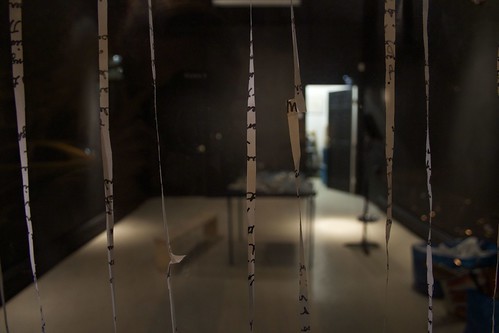
Photo: Dennis Friedler
During my Eleventh Week at 55 Norfolk Street I traversed a permeable interface between two performance texts. I spun the last bit of the Serres text, now living as several balls of yarn, performed over the course of six evenings in the space. Meanwhile a new text, the mystical poetry of Jaime Saenz, entered transcription. I thought about these two texts, chosen for their relationship to passage, and my body as a medium for textual transformation through time and space, an instrument of energy transfer, body-to-paper. Turning the wheel of the sidewinder, I thought about this amazing coalescence. I considered as well, the opposing narratives of these two texts - one rooted in the instinct for survival through passage - the other embodying a living desire to know the wisdom of death. Through all of this, at the core of my awareness, I experienced agonizing back pain demanding full surrender if I had any hope of fulfilling my commitment to perform.

Photo: Dennis Friedler
The pain in my back intensified as the night wore on, thrusting me into an acute state of vigilance and concentration. I became hyperaware of every move, every gesture. Not impeding, but rather encouraging a wider range of movement, the pain quickened my pace and impelled me to use more of the space as I alternated between transcription in one window, spinning in the other, and winding a yarn skein in the central window of the door. The winding offered some modicum of relief as I sat on buckwheat cushions set out on the floor. There was something different about this set of engaged actions and my perception of time - my arms felt longer, especially with the spinning. I shifted my weight about more consciously, veritably dancing with the text.
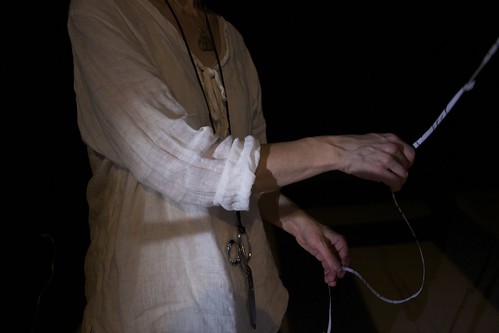
Photo: Dennis Friedler
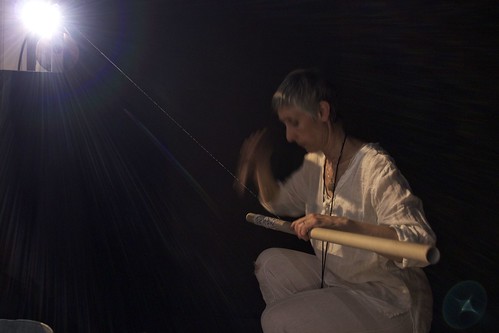
Photo: Dennis Friedler
My recurrent engrossment with souls in transit was centered on what was happening in the door, reflecting Bob's picture, and where I'd strung a long line of Serres text - the last bit of unspun paper. The paper wound its way up and around, down and around, on tension rods affixed above and below the door window. I would pull slowly, gently to release a length of paper for spinning. This created an enchanting effect as fragments of text traveled in both directions simultaneously - a sailor's tale of passage through fire and ice going both ways at once.

Photo: Dennis Friedler
Many thanks to Anna Wexler, contributor of a new performance text that I transcribed fully this Eleventh Week under great duress of pain, agonizingly liberating:
To Cross This Distance (X), by Jaime Saenz, from IMMANENT VISITOR, Selected Poems of Jaime Saenz
Translated from the Spanish by Kent Johnson and Forrest Gander
X
In the world's deep realms are great spaces
- a nothingness ruled over by nothingness itself,
which is cause and origin of the first terror, of thought and echo.
Inconceivable depths exist, hollows before whose allure, before whose haunting
spell,
one would surely and simply die.
Sounds one would surely yearn to hear, forms and visions one would surely yearn
to see,
things one would surely yearn to touch, revelations one would surely yearn to
know,
who knows with what secret yearning and coming to know who knows what.
_______
In the essential soul of the world's synchrony and duration,
buried in the abyss from which the world arose, and embedded in the marrow of
the world,
an odor can be sensed, which you will recognize at once, for you have never
known another like it;
the odor of truth, the only one, the odor of the abyss - and you will have to
know it.
Because only when you come to know it will you understand how it's always been
true that wisdom coheres in the absence of air.

Photo: Dennis Friedler
In the deepest darkness of the world, wisdom will offer itself, in the hermetic
kingdoms of the soul;
in the vicinities of fire and in fire itself, in which the selfsame fire together with air
is devoured by darkness.
And it is because no one has any idea of the abyss, and because no one has known
the abyss, nor has sensed the odor of the abyss,
that wisdom cannot be spoken of among men, among the living.
While alive, man will not be able to understand the world; man ignores the fact
that as long as he doesn't leave off living, he will not be wise.
He fears everything that borders on wisdom; as soon as he can't understand, he
distrusts
- he understands nothing outside the living.
And I say that one should strive to be dead.
To do so at all costs, before dying. One would need to do everything possible to
be dead.
The waters tell you of it - fire, air, and the light, in clearest speech
To be dead.
Love tells you of it, the world and all manner of things, to be dead.
Darkness tells nothing. it is pure silence.
One has to think of the sealed spaces. Of the vaults opening beneath the oceans,
of the caverns and the grottoes - one has to think of the fissures, of the infinite
tunnels in the umbrae.
If you think of yourself, all your body and soul, you will be the world - in its
innerness and in its visible forms.
Become accustomed to thinking intently of one thing; everything is dark.
Thus, darkness is the world's law; fire fans the darkness and goes out - it is
devoured by darkness.
I say this: it is necessary to think of the world - what is inside the world gives me
much to think about. I am dark.
I'm not interested in thinking of the world beyond the world; light is interrupting,
as is living - which is transitory.
What could living ever have to do with life; living is one thing, life is another.
Life and death are one.

Photo: Dennis Friedler
There were no mail slot contributions this night. I did have one gentleman stop, after I had ended the performance and was packing up, who donned a set of headphones, listened intently to my performance text narration, and gave me a thumbs up when he was finished.
Wrapped Intention: Eleventh Week

Photo: Dennis Friedler
During my Eleventh Week at 55 Norfolk Street I traversed a permeable interface between two performance texts. I spun the last bit of the Serres text, now living as several balls of yarn, performed over the course of six evenings in the space. Meanwhile a new text, the mystical poetry of Jaime Saenz, entered transcription. I thought about these two texts, chosen for their relationship to passage, and my body as a medium for textual transformation through time and space, an instrument of energy transfer, body-to-paper. Turning the wheel of the sidewinder, I thought about this amazing coalescence. I considered as well, the opposing narratives of these two texts - one rooted in the instinct for survival through passage - the other embodying a living desire to know the wisdom of death. Through all of this, at the core of my awareness, I experienced agonizing back pain demanding full surrender if I had any hope of fulfilling my commitment to perform.

Photo: Dennis Friedler
The pain in my back intensified as the night wore on, thrusting me into an acute state of vigilance and concentration. I became hyperaware of every move, every gesture. Not impeding, but rather encouraging a wider range of movement, the pain quickened my pace and impelled me to use more of the space as I alternated between transcription in one window, spinning in the other, and winding a yarn skein in the central window of the door. The winding offered some modicum of relief as I sat on buckwheat cushions set out on the floor. There was something different about this set of engaged actions and my perception of time - my arms felt longer, especially with the spinning. I shifted my weight about more consciously, veritably dancing with the text.

Photo: Dennis Friedler

Photo: Dennis Friedler
My recurrent engrossment with souls in transit was centered on what was happening in the door, reflecting Bob's picture, and where I'd strung a long line of Serres text - the last bit of unspun paper. The paper wound its way up and around, down and around, on tension rods affixed above and below the door window. I would pull slowly, gently to release a length of paper for spinning. This created an enchanting effect as fragments of text traveled in both directions simultaneously - a sailor's tale of passage through fire and ice going both ways at once.

Photo: Dennis Friedler
Many thanks to Anna Wexler, contributor of a new performance text that I transcribed fully this Eleventh Week under great duress of pain, agonizingly liberating:
To Cross This Distance (X), by Jaime Saenz, from IMMANENT VISITOR, Selected Poems of Jaime Saenz
Translated from the Spanish by Kent Johnson and Forrest Gander
X
In the world's deep realms are great spaces
- a nothingness ruled over by nothingness itself,
which is cause and origin of the first terror, of thought and echo.
Inconceivable depths exist, hollows before whose allure, before whose haunting
spell,
one would surely and simply die.
Sounds one would surely yearn to hear, forms and visions one would surely yearn
to see,
things one would surely yearn to touch, revelations one would surely yearn to
know,
who knows with what secret yearning and coming to know who knows what.
_______
In the essential soul of the world's synchrony and duration,
buried in the abyss from which the world arose, and embedded in the marrow of
the world,
an odor can be sensed, which you will recognize at once, for you have never
known another like it;
the odor of truth, the only one, the odor of the abyss - and you will have to
know it.
Because only when you come to know it will you understand how it's always been
true that wisdom coheres in the absence of air.

Photo: Dennis Friedler
In the deepest darkness of the world, wisdom will offer itself, in the hermetic
kingdoms of the soul;
in the vicinities of fire and in fire itself, in which the selfsame fire together with air
is devoured by darkness.
And it is because no one has any idea of the abyss, and because no one has known
the abyss, nor has sensed the odor of the abyss,
that wisdom cannot be spoken of among men, among the living.
While alive, man will not be able to understand the world; man ignores the fact
that as long as he doesn't leave off living, he will not be wise.
He fears everything that borders on wisdom; as soon as he can't understand, he
distrusts
- he understands nothing outside the living.
And I say that one should strive to be dead.
To do so at all costs, before dying. One would need to do everything possible to
be dead.
The waters tell you of it - fire, air, and the light, in clearest speech
To be dead.
Love tells you of it, the world and all manner of things, to be dead.
Darkness tells nothing. it is pure silence.
One has to think of the sealed spaces. Of the vaults opening beneath the oceans,
of the caverns and the grottoes - one has to think of the fissures, of the infinite
tunnels in the umbrae.
If you think of yourself, all your body and soul, you will be the world - in its
innerness and in its visible forms.
Become accustomed to thinking intently of one thing; everything is dark.
Thus, darkness is the world's law; fire fans the darkness and goes out - it is
devoured by darkness.
I say this: it is necessary to think of the world - what is inside the world gives me
much to think about. I am dark.
I'm not interested in thinking of the world beyond the world; light is interrupting,
as is living - which is transitory.
What could living ever have to do with life; living is one thing, life is another.
Life and death are one.

Photo: Dennis Friedler
There were no mail slot contributions this night. I did have one gentleman stop, after I had ended the performance and was packing up, who donned a set of headphones, listened intently to my performance text narration, and gave me a thumbs up when he was finished.
Comments
by Catherine (not verified) | Tue, 2012-05-15 09:48
Thanks Margaret!
Thanks Margaret!
Wrapped Intention: Tenth Week : Catherine Tutter
Tue Apr 17, 2012
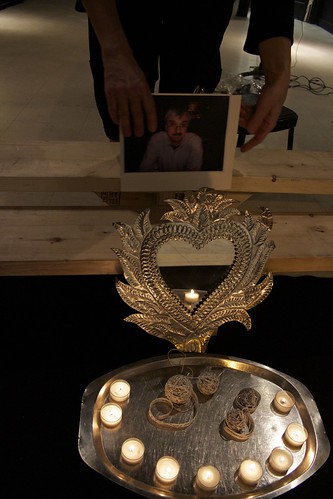
Photo: Dennis Friedler
I'm reaching the end of my engagement with the performance text from Michel Serres, contributed by Sarah Bliss. This is the third and longest text to journey through transcription, reflection, separation and reconstitution into a completely new language, a changed physical state altogether. I'm accumulating precious balls of delicate yarn, offspring of these transformations. Their presence is taking on some new significance but I can't explain what exactly. For now, I keep them close to candlelight, imbued with heat, with warmth. I was filled with joy when I discovered a heart-shaped mirror in the space as I set up for performance. This one remindeded me of Vodou forms associated with Erzulie Freda and I decided to create a shrine with Bob's picture to align with the door.

Photo: Dennis Friedler
Dennis was actively photographing both inside and outside the space this evening. He captured an arresting reflection of Bob's shrine in the doorway, auspiciously merged with a viewer who spent several minutes actively observing my spinning, his hands gracefully clasped, his bearing regal.

Photo: Dennis Friedler
A similar mirroring of my scissors with this visitor made me glad I chose to wear them around my neck for the sake of practicality.
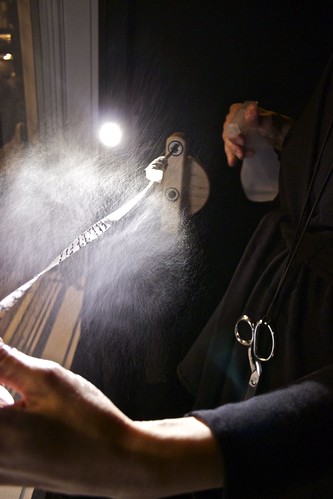
Photo: Dennis Friedler
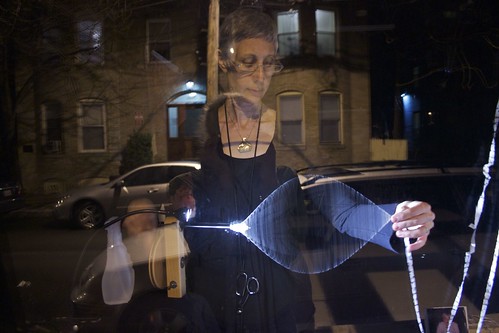
Photo: Dennis Friedler
The spinning is incredibly seductive. The ballooning yarn buzzes like a life form as I lose myself in the forces of centripetal motion, my gaze fixed on the skin of this expanding volumetric space. Turning the wheel of the sidewinder, I think about souls of the dead in transit. What would it be to pass through this diaphanous container?

Photo: Dennis Friedler
I spent several hours in the space this night, well past 2:00 am as I endeavored to push through and complete the spinning of Serres' text. Deep fatigue took hold and I did not succeed, leaving the space with a significant length of 1/4" paper strip to carry through into Week Eleven. My perceived failure to complete the transformative work begged the question: What exactly was I attempting to finish?

Photo: Dennis Friedler
Passersby continue to give new dimension to my investigation.
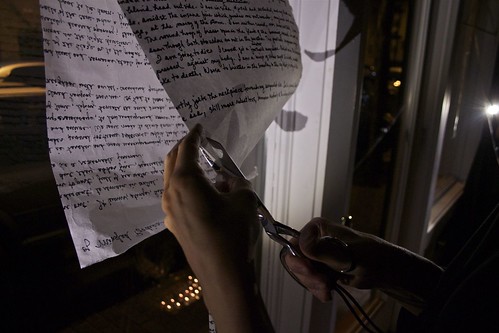
Photo: Dennis Friedler
I was able to complete my separation of the Serres text; the last remaining strips from this sheet will journey through spinning at Week Eleven.
Entering a new performance text through transcription while simultaneously spinning what remains of Serres' THE FIVE SENSES is the direction I'm headed for my Eleventh Week. I envision the yarns assuming a pivotal place - the door perhaps? My thoughts return to the mirroring shrine emblazoned on the window of the door as it chose its partner in a moment of passage. These windows are monumental in my interior world. I'm thinking about ways I might use their full height more substantively.

Photo: Dennis Friedler
Appreciation and thanks to Anna Wexler for stopping by.
No contributions passed through the mail slot this Tenth Week.

Photo: Dennis Friedler
I'm reaching the end of my engagement with the performance text from Michel Serres, contributed by Sarah Bliss. This is the third and longest text to journey through transcription, reflection, separation and reconstitution into a completely new language, a changed physical state altogether. I'm accumulating precious balls of delicate yarn, offspring of these transformations. Their presence is taking on some new significance but I can't explain what exactly. For now, I keep them close to candlelight, imbued with heat, with warmth. I was filled with joy when I discovered a heart-shaped mirror in the space as I set up for performance. This one remindeded me of Vodou forms associated with Erzulie Freda and I decided to create a shrine with Bob's picture to align with the door.

Photo: Dennis Friedler
Dennis was actively photographing both inside and outside the space this evening. He captured an arresting reflection of Bob's shrine in the doorway, auspiciously merged with a viewer who spent several minutes actively observing my spinning, his hands gracefully clasped, his bearing regal.

Photo: Dennis Friedler
A similar mirroring of my scissors with this visitor made me glad I chose to wear them around my neck for the sake of practicality.

Photo: Dennis Friedler

Photo: Dennis Friedler
The spinning is incredibly seductive. The ballooning yarn buzzes like a life form as I lose myself in the forces of centripetal motion, my gaze fixed on the skin of this expanding volumetric space. Turning the wheel of the sidewinder, I think about souls of the dead in transit. What would it be to pass through this diaphanous container?

Photo: Dennis Friedler
I spent several hours in the space this night, well past 2:00 am as I endeavored to push through and complete the spinning of Serres' text. Deep fatigue took hold and I did not succeed, leaving the space with a significant length of 1/4" paper strip to carry through into Week Eleven. My perceived failure to complete the transformative work begged the question: What exactly was I attempting to finish?

Photo: Dennis Friedler
Passersby continue to give new dimension to my investigation.

Photo: Dennis Friedler
I was able to complete my separation of the Serres text; the last remaining strips from this sheet will journey through spinning at Week Eleven.
Entering a new performance text through transcription while simultaneously spinning what remains of Serres' THE FIVE SENSES is the direction I'm headed for my Eleventh Week. I envision the yarns assuming a pivotal place - the door perhaps? My thoughts return to the mirroring shrine emblazoned on the window of the door as it chose its partner in a moment of passage. These windows are monumental in my interior world. I'm thinking about ways I might use their full height more substantively.

Photo: Dennis Friedler
Appreciation and thanks to Anna Wexler for stopping by.
No contributions passed through the mail slot this Tenth Week.
Wrapped Intention: Ninth Week : Catherine Tutter
Wed Apr 11, 2012

Photo: Dennis Friedler
My work continues with an excerpt from Michel Serres' THE FIVE SENSES, contributed by Sarah Bliss, transcribed over two performance periods, Sixth Week and Seventh Week. I added an audio narration of the text for audience members to listen to; a pair of headsets are now available outside the space for the duration of this series. Many thanks to Alex Buchanan, a photographer and mariner, for performing Serres' text through spoken narration.
This week I deployed both windows on either side of the door as loci for deconstruction and re-creation, respectively. I set up two folding tables to create raised platforms, setting my full body squarely in each window, using a short set of stairs to allow for safe ascending and descending. I took my scissors to the first half of the excerpt in one window and completed spinning the second half of the excerpt in the other. I considered the front door as a liminal boundary for my passage between alternating actions.
I was outside briefly to adjust the positioning of the headset when I was greeted by three friends - they asked if they could follow me inside...it was cold. I decided to go with this. They sat quietly with me in the space, allowing me to settle into performance without speaking. It was good to have them with me in the interior. I've been thinking about these divides - inner, outer - what passes through. When Dennis entered the space to photograph - my trio departed.
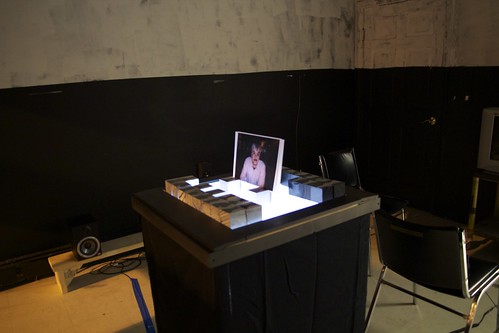
Photo: Dennis Friedler
In the space this evening was an installation connected to Mobius' collaboration with Together Festival. A central feature was a standing pedestal with an internally-illuminated chess board, as in a light box. I placed Bob's picture in the center of the chess board, his visage bathed in cool blue light. Notwithstanding the rich allegories of chess, the exact alignment of the chess board apparatus with the front door gave me pause. In some cultures, passage of the souls of the dead take time to complete their journeys. Is Bob's soul still in transit? This question occupied my thoughts as I moved between these windows of transformation.
My intention with Alex's audio narration was to set it to loop. I was not able to solve this problem in time for tonight's performance so I equipped myself with a kitchen timer set to 11 minutes, the run-time of the recording. The short, loud ring of the timer was a signal to cease my action (whether cutting or spinning), descend the stairs, set the audio to replay, re-set the timer, and ascend the alternate platform to take up the next action. This movement between actions, between worlds, was repeated at every timed interval for the two-hour duration.

Photo: Dennis Friedler
For this performance I switched from using a drop spindle to a side-winder, a hand-crank apparatus. Spinning yarn on a side winder creates the exquisite effect of "ballooning", a phenomenon of physics and a highly-studied subject within industrial textile manufacture that I'd like to learn more about. I've long been fascinated and mesmerized by the predictable expansion and contraction of this geometric surface, fading into momentary disappearance, at times replicating itself into two or even three balloons.
What's at the root of these forms and what might they say about dimensions of travel, of passage?
This contribution came through the mail slot:
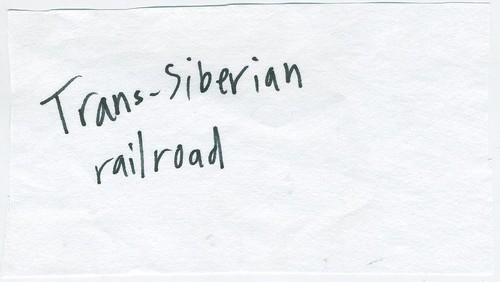
And from Alex Buchanan, my performance text narrator:


Photo: Dennis Friedler
My work continues with an excerpt from Michel Serres' THE FIVE SENSES, contributed by Sarah Bliss, transcribed over two performance periods, Sixth Week and Seventh Week. I added an audio narration of the text for audience members to listen to; a pair of headsets are now available outside the space for the duration of this series. Many thanks to Alex Buchanan, a photographer and mariner, for performing Serres' text through spoken narration.
This week I deployed both windows on either side of the door as loci for deconstruction and re-creation, respectively. I set up two folding tables to create raised platforms, setting my full body squarely in each window, using a short set of stairs to allow for safe ascending and descending. I took my scissors to the first half of the excerpt in one window and completed spinning the second half of the excerpt in the other. I considered the front door as a liminal boundary for my passage between alternating actions.
I was outside briefly to adjust the positioning of the headset when I was greeted by three friends - they asked if they could follow me inside...it was cold. I decided to go with this. They sat quietly with me in the space, allowing me to settle into performance without speaking. It was good to have them with me in the interior. I've been thinking about these divides - inner, outer - what passes through. When Dennis entered the space to photograph - my trio departed.

Photo: Dennis Friedler
In the space this evening was an installation connected to Mobius' collaboration with Together Festival. A central feature was a standing pedestal with an internally-illuminated chess board, as in a light box. I placed Bob's picture in the center of the chess board, his visage bathed in cool blue light. Notwithstanding the rich allegories of chess, the exact alignment of the chess board apparatus with the front door gave me pause. In some cultures, passage of the souls of the dead take time to complete their journeys. Is Bob's soul still in transit? This question occupied my thoughts as I moved between these windows of transformation.
My intention with Alex's audio narration was to set it to loop. I was not able to solve this problem in time for tonight's performance so I equipped myself with a kitchen timer set to 11 minutes, the run-time of the recording. The short, loud ring of the timer was a signal to cease my action (whether cutting or spinning), descend the stairs, set the audio to replay, re-set the timer, and ascend the alternate platform to take up the next action. This movement between actions, between worlds, was repeated at every timed interval for the two-hour duration.

Photo: Dennis Friedler
For this performance I switched from using a drop spindle to a side-winder, a hand-crank apparatus. Spinning yarn on a side winder creates the exquisite effect of "ballooning", a phenomenon of physics and a highly-studied subject within industrial textile manufacture that I'd like to learn more about. I've long been fascinated and mesmerized by the predictable expansion and contraction of this geometric surface, fading into momentary disappearance, at times replicating itself into two or even three balloons.
What's at the root of these forms and what might they say about dimensions of travel, of passage?
This contribution came through the mail slot:

And from Alex Buchanan, my performance text narrator:

Low Concept: gestures from O Superman : David Miller
Sat Apr 07, 2012
There were three sources of preexisting material in the performances of Low Concept: Brecht/Weill's song Die Seeräuber-Jenny ("Pirate Jenny"), the Adagio from Ravel's G major piano concerto, and Laurie Anderson's music O Superman music video. The first was evident, as I exposed the song in four stages, concluding with a kind of performance/staging in German. The second remained unnamed: I performed the first part of the Adagio, transcribed for a single piano, on a toy piano. If someone knew the music well enough they might have recognized it, though I don't believe anyone did. The third remained quite buried. I quoted only a brief passage from Anderson's lyrics, and only once. What I did quote and enact, at several points, was a description of the gestures she uses in her original music video (viewable here for example). Interesting intellectual property question, possibly: the video work is hers, her performance is hers, but the text below is "mine," I believe.
I did not attempt to describe one passage ("neither snow nor rain" etc.) where she makes use of sign language. I didn't want to hack around with a language I do not understand - like imitating the sounds of a spoken language you don't understand. You could just wind up mocking people.
The full rendition of Pirate Jenny segued directly into the italicized portion of the text below, which the audience had seen three times before, but now for the first time with the words: 'Cause when love is gone/there's always justice/and when justice is gone/there's always force/and when force is gone/there's always Mom/Hi Mom. That may have been the moment when people suddenly realized why Laurie Anderson was credited on the program. (Thank you Laurie Anderson. I still love this work.)
O Superman gesture score
Left arm raised, elbow at chest height and bent, fist closed at shoulder height
lowered almost horizontally, raised again, lowered, raised again
hand open, fingers together, thumb separate – elbow straightened and bent in a stiff handwaving gesture
arm dropped to side
arms at sides, elbows at sides, forearms slightly extended – straighten elbows so arms angled away from body
raise forearms and elbows away from sides – elbows bent at chest height, forearms up making V, hands open
then curl hands in to body above shoulder height
open hands flat again, make “money” gesture with fingers
rotate hands so backs of hands are toward body, forefingers point horizontally away from body
open hands flat so palms face front
left arm, elbow at side, palm open to front, 3rd-5th fingers curled slightly in front of index finger
gun gesture with thumb and index finger, 3rd-5th fingers curled in to palm
palm opens, facing up – forearm still at same angle to body and elbow at side
turn palm to face front, move palm toward viewer
right arm crossed in front of body, hand open, fingers together, placed above heart
open arm extended to right, elbow close to but not at body, slightly bent – forearm horizontal
turn palm up, raise left arm and hand in same position –look at left hand – tilt arms back and forth
turn arms over, palms down but curled out as if pushing away, then lower arms at sides and look down
raise arms away from body, elbows bent at chest height, fists at eye level
then drop arms – inverted, forearms hang vertically from bent elbow in same position, fists hanging at end of forearms
then repeat raising and dropping fists
raise arms to same height, elbows bent at same height, open palms pointing up making 90 degree angle with head
then move hands to face front
relax hands
lower left arm to horizontal position, hand open but facing down, wave hello with right arm in same position
Left arm raised, elbow at chest height and bent, fist closed at shoulder height
straighten elbow and extend arm, palm facing front, fingers together, thumb separate
bend elbow so upper arm is at 90 degree angle, separate all fingers and thumb, palm still forward
straighten elbow and turn hand into gun gesture
bend elbow and raise hand with gun gesture – when index finger is pointing up, curl hand into fist
straighten elbow with fist – when arm horizontal, point sideways with index finger
bend elbow with index finger extended – when index finger pointing up, curl hand to make a bird head silhouette
extend bird head slightly – open “beak” three times
raise hand to face front, open fingers, forearm toward body, elbow in same position
straighten elbow and extend hand with pointing forefinger
bend elbow and turn forefinger so pointing at self
turn hand and make “rabbit” with thumb and forefinger curled and touching, three fingers curled above
quickly extend forefinger pointing to left
bend elbow, open hand facing front, open fingers – bend elbow further so open hand angles towards body, then
straighten elbow so hand faces out
bend elbow again
straighten elbow so index and middle fingers extended, together, point left, thumb atop index finger, other fingers curled in
bend elbow so index and middle fingers point up
straighten elbow, then bend it again, all fingers together, palm slightly curling so fingertips point toward body
straighten elbow, palm facing up, pull left sleeve with right arm
bend elbow to make fist – facing toward body
straighten elbow – index finger pointing left
bend elbow – fist turns toward body, index finger curls over fist
mostly straighten elbow – relaxed finger extends at a gentle angle upward and out
immediately bend elbow, open fingers, palm facing front
straight elbow, palm forward – repeatedly bend and flex elbow with open fingers facing forward, increasing pace
end in fist with elbow bent
Notated by David Miller, March 2012
There were three sources of preexisting material in the performances of Low Concept: Brecht/Weill's song Die Seeräuber-Jenny ("Pirate Jenny"), the Adagio from Ravel's G major piano concerto, and Laurie Anderson's music O Superman music video. The first was evident, as I exposed the song in four stages, concluding with a kind of performance/staging in German. The second remained unnamed: I performed the first part of the Adagio, transcribed for a single piano, on a toy piano. If someone knew the music well enough they might have recognized it, though I don't believe anyone did. The third remained quite buried. I quoted only a brief passage from Anderson's lyrics, and only once. What I did quote and enact, at several points, was a description of the gestures she uses in her original music video (viewable here for example). Interesting intellectual property question, possibly: the video work is hers, her performance is hers, but the text below is "mine," I believe.
I did not attempt to describe one passage ("neither snow nor rain" etc.) where she makes use of sign language. I didn't want to hack around with a language I do not understand - like imitating the sounds of a spoken language you don't understand. You could just wind up mocking people.
The full rendition of Pirate Jenny segued directly into the italicized portion of the text below, which the audience had seen three times before, but now for the first time with the words: 'Cause when love is gone/there's always justice/and when justice is gone/there's always force/and when force is gone/there's always Mom/Hi Mom. That may have been the moment when people suddenly realized why Laurie Anderson was credited on the program. (Thank you Laurie Anderson. I still love this work.)
O Superman gesture score
Left arm raised, elbow at chest height and bent, fist closed at shoulder height
lowered almost horizontally, raised again, lowered, raised again
hand open, fingers together, thumb separate – elbow straightened and bent in a stiff handwaving gesture
arm dropped to side
arms at sides, elbows at sides, forearms slightly extended – straighten elbows so arms angled away from body
raise forearms and elbows away from sides – elbows bent at chest height, forearms up making V, hands open
then curl hands in to body above shoulder height
open hands flat again, make “money” gesture with fingers
rotate hands so backs of hands are toward body, forefingers point horizontally away from body
open hands flat so palms face front
left arm, elbow at side, palm open to front, 3rd-5th fingers curled slightly in front of index finger
gun gesture with thumb and index finger, 3rd-5th fingers curled in to palm
palm opens, facing up – forearm still at same angle to body and elbow at side
turn palm to face front, move palm toward viewer
right arm crossed in front of body, hand open, fingers together, placed above heart
open arm extended to right, elbow close to but not at body, slightly bent – forearm horizontal
turn palm up, raise left arm and hand in same position –look at left hand – tilt arms back and forth
turn arms over, palms down but curled out as if pushing away, then lower arms at sides and look down
raise arms away from body, elbows bent at chest height, fists at eye level
then drop arms – inverted, forearms hang vertically from bent elbow in same position, fists hanging at end of forearms
then repeat raising and dropping fists
raise arms to same height, elbows bent at same height, open palms pointing up making 90 degree angle with head
then move hands to face front
relax hands
lower left arm to horizontal position, hand open but facing down, wave hello with right arm in same position
Left arm raised, elbow at chest height and bent, fist closed at shoulder height
straighten elbow and extend arm, palm facing front, fingers together, thumb separate
bend elbow so upper arm is at 90 degree angle, separate all fingers and thumb, palm still forward
straighten elbow and turn hand into gun gesture
bend elbow and raise hand with gun gesture – when index finger is pointing up, curl hand into fist
straighten elbow with fist – when arm horizontal, point sideways with index finger
bend elbow with index finger extended – when index finger pointing up, curl hand to make a bird head silhouette
extend bird head slightly – open “beak” three times
raise hand to face front, open fingers, forearm toward body, elbow in same position
straighten elbow and extend hand with pointing forefinger
bend elbow and turn forefinger so pointing at self
turn hand and make “rabbit” with thumb and forefinger curled and touching, three fingers curled above
quickly extend forefinger pointing to left
bend elbow, open hand facing front, open fingers – bend elbow further so open hand angles towards body, then
straighten elbow so hand faces out
bend elbow again
straighten elbow so index and middle fingers extended, together, point left, thumb atop index finger, other fingers curled in
bend elbow so index and middle fingers point up
straighten elbow, then bend it again, all fingers together, palm slightly curling so fingertips point toward body
straighten elbow, palm facing up, pull left sleeve with right arm
bend elbow to make fist – facing toward body
straighten elbow – index finger pointing left
bend elbow – fist turns toward body, index finger curls over fist
mostly straighten elbow – relaxed finger extends at a gentle angle upward and out
immediately bend elbow, open fingers, palm facing front
straight elbow, palm forward – repeatedly bend and flex elbow with open fingers facing forward, increasing pace
end in fist with elbow bent
Notated by David Miller, March 2012
Labels:
David Miller
Low Concept: Saturday night open source text : David Miller
Sat Apr 07, 2012
This is the text generated by the audience members and me during the Low Concept performance on Saturday. This is available for anyone to use for any purpose, in part or whole, as long as it's noncommercial and you share alike: "Low Concept performance text by No Attribution Needed is licensed under a Creative Commons Attribution-NonCommercial-ShareAlike 3.0 Unported License. Based on a work at http://www.mobius.org/blog/david-miller." You don't have to attribute it, but do let me know about it.
One difference from the Friday night text is that, on Saturday, I asked questions of the audience by typing them so they displayed on the screen. Friday's questions were posed verbally, and are not part of the text. But as on Friday, "I" refers to different people at different times.
Performance text, Saturday, March 31, 2012
Saturday night text
We’re doing introductions. Meeting each other again after a long more or less pause, hiatus, however you want to express it, I guess. I am glad to see you all in the same room. I don’t think that’s really happened many times, even considering the time that has gone by. So, so, next thought. Straight against the keyboard, Fingertips. Sound of keys, sound of cameras, sound of breathing, my own heart, actually. Actually what? What follows actually? Not entirely sure. I was about to finish that sentence with something definite and affirmative, and in fact there’s probably something there but I don’t any longer know what it is. Especially as I get farther away from the sentence itself. Wilful self-distraction.
I will ask you a question or two during the course of the performance. I hope you will feel comfortable answering this question, these questions. No assumptions though.
A string of lights in the window in the house opposite. White strings of holiday lights, probably suspended across the glass of the window, but perhaps actually suspended in the room itself? Not that plausible, I guess, not impossible either.
Save file. Oh and yes, this isn’t a Mac. But I don’t get religious about it.
Question: when you were young (any young age counts), something happened to you that - say - opened your mind to the rest of what your life might be. Surely this happened to you. I can say this because I am fortunate to know all of you in the room.
So -- would someone like to mention something to us along this line - and may I enter it here?
I wrote my first poem when I was 10 and my teacher asked me if I had plagiarized it. I asked, what does that mean?
My teacher said, did your parents help you write it? My answer was no.
When I was 19, I was cast as Sonya in Uncle Vanya by Chekhov and that probably answers the question.
One more?
When I was in the third grade I wrote a book report on flying saucers. One of my sources was my coach, who had been in the air force. He was pursuing flyers saucers and found he could not match the subtlety of their movement. It changed his life and hearing about this changed my life.
Thanks.
Another question: what do you have nostalgia for?
The present. (And how is the present an object of nostalgia? No really.)
Because I miss everything even as it’s happening.
Yes, I get that.
The Sixties. No, really, too. I was listening to the Rutles album Archaeology just this afternoon.
Another?
My son when he was just a small child.
Thanks.
Scraping, rubbing, tearing. Last summer we visited the Skowhegan School of Painting and Sculpture in Maine. Several of us from Mobius and me. Performing a piece by John Cage called Variations VIII. The idea - go to a place you do not know and have never been to before. Make a performance based only on what you find there. Bring nothing. So we did, six of us. Jane Wang, Jed Speare, Margaret Bellafiore, me, Larry Johnson, and Bob Raymond. My part of the performance ended with Bob and I working together. The building was set at the bottom of a kind of kettlebowl. The rim of the kettlebowl was lined with large boulders. Bob and I took scrapers from the fresco studio in the same building and a remote microphone and walked from boulder to boulder, scraping and sounding as the sound came out from inside the building and the audience came out of the building and sat on the grass under the stars. Which then is where we had Q and A afterwards.
One more question.
What were you just thinking about now?
His uncle who just passed away yesterday. I am very sorry to hear this, Andrew.
That I miss Bob.
Another?
Or you can bring it in later.
Same question, maybe? What is on your mind just now? Or, ow.
The answer to your question was on my mind.
And do I assume correctly that this was it?
Yes.
Yes I said yes I will yes.
This is the text generated by the audience members and me during the Low Concept performance on Saturday. This is available for anyone to use for any purpose, in part or whole, as long as it's noncommercial and you share alike: "Low Concept performance text by No Attribution Needed is licensed under a Creative Commons Attribution-NonCommercial-ShareAlike 3.0 Unported License. Based on a work at http://www.mobius.org/blog/david-miller." You don't have to attribute it, but do let me know about it.
One difference from the Friday night text is that, on Saturday, I asked questions of the audience by typing them so they displayed on the screen. Friday's questions were posed verbally, and are not part of the text. But as on Friday, "I" refers to different people at different times.
Performance text, Saturday, March 31, 2012
Saturday night text
We’re doing introductions. Meeting each other again after a long more or less pause, hiatus, however you want to express it, I guess. I am glad to see you all in the same room. I don’t think that’s really happened many times, even considering the time that has gone by. So, so, next thought. Straight against the keyboard, Fingertips. Sound of keys, sound of cameras, sound of breathing, my own heart, actually. Actually what? What follows actually? Not entirely sure. I was about to finish that sentence with something definite and affirmative, and in fact there’s probably something there but I don’t any longer know what it is. Especially as I get farther away from the sentence itself. Wilful self-distraction.
I will ask you a question or two during the course of the performance. I hope you will feel comfortable answering this question, these questions. No assumptions though.
A string of lights in the window in the house opposite. White strings of holiday lights, probably suspended across the glass of the window, but perhaps actually suspended in the room itself? Not that plausible, I guess, not impossible either.
Save file. Oh and yes, this isn’t a Mac. But I don’t get religious about it.
Question: when you were young (any young age counts), something happened to you that - say - opened your mind to the rest of what your life might be. Surely this happened to you. I can say this because I am fortunate to know all of you in the room.
So -- would someone like to mention something to us along this line - and may I enter it here?
I wrote my first poem when I was 10 and my teacher asked me if I had plagiarized it. I asked, what does that mean?
My teacher said, did your parents help you write it? My answer was no.
When I was 19, I was cast as Sonya in Uncle Vanya by Chekhov and that probably answers the question.
One more?
When I was in the third grade I wrote a book report on flying saucers. One of my sources was my coach, who had been in the air force. He was pursuing flyers saucers and found he could not match the subtlety of their movement. It changed his life and hearing about this changed my life.
Thanks.
Another question: what do you have nostalgia for?
The present. (And how is the present an object of nostalgia? No really.)
Because I miss everything even as it’s happening.
Yes, I get that.
The Sixties. No, really, too. I was listening to the Rutles album Archaeology just this afternoon.
Another?
My son when he was just a small child.
Thanks.
Scraping, rubbing, tearing. Last summer we visited the Skowhegan School of Painting and Sculpture in Maine. Several of us from Mobius and me. Performing a piece by John Cage called Variations VIII. The idea - go to a place you do not know and have never been to before. Make a performance based only on what you find there. Bring nothing. So we did, six of us. Jane Wang, Jed Speare, Margaret Bellafiore, me, Larry Johnson, and Bob Raymond. My part of the performance ended with Bob and I working together. The building was set at the bottom of a kind of kettlebowl. The rim of the kettlebowl was lined with large boulders. Bob and I took scrapers from the fresco studio in the same building and a remote microphone and walked from boulder to boulder, scraping and sounding as the sound came out from inside the building and the audience came out of the building and sat on the grass under the stars. Which then is where we had Q and A afterwards.
One more question.
What were you just thinking about now?
His uncle who just passed away yesterday. I am very sorry to hear this, Andrew.
That I miss Bob.
Another?
Or you can bring it in later.
Same question, maybe? What is on your mind just now? Or, ow.
The answer to your question was on my mind.
And do I assume correctly that this was it?
Yes.
Yes I said yes I will yes.
Labels:
David Miller
Low Concept: Friday night open source text : David Miller
Sat Apr 07, 2012
During each performance I did a fair amount of free-text writing from my notebook computer, projected for the audience to read on a larger monitor. You can see this in one of the photographs. I also asked questions of the audience during the performance, and incorporated their answers into the writing. So that for example, "I" in the resulting text often, but not always, refers to me.
I told each night's audience, and now I'm telling anyone who reads this, that this collective writing is available for anyone to make use of, in whole or in part, for any other purpose except commercial purposes. Anyone includes you, whether you came to the performance or not. To use the Creative Commons language: "Low Concept performance text by No Attribution Needed is licensed under a Creative Commons Attribution-NonCommercial-ShareAlike 3.0 Unported License. Based on a work at http://www.mobius.org/blog/david-miller." No attribution to me is necessary, but do let me know if you use this and how you used it. I'm just curious about it.
Performance text, Friday, March 30, 2012
Friday night text - Low Concept
It’s 8 pm, so we’re beginning. People I haven’t seen in quite awhile are here, as well as a couple of people I haven’t met, or don’t recall having met ….
One question I have for myself in doing this kind of writing is whether or not I should keep the typos. I, no that’s an example right there, I was going to begin with a sentence with “I”, then changed my mind, then changed my mind back again to start the sentence with “I” as I just did. But I still, or perhaps “till” haven’t answered the question about the typos and probably won’t answer that question. Here is George Moseley. Now he’s is going around, no he’s not yet going around to the side, he’s standing by his bicycle. But I think he gets it. George is sharp like that, or “shart” whatever that is. People think I type quickly who only listen but that’s because they are also listening to me backspace to correct mistakes. Too hasty.
First thought, best thought, Ginsberg said, but I can’t say I always agree with that, no disrespect to his memory. By, or but, first thought is more or less what this is about. Well, first thought and then second thought. This keyboard has one key positioned differently from my last laptop, so characteristically I wind up highlighting and deleting a whole lot of text, fortunately I can undo it if I catch it in time. Like that for instance. If I could figure out the problem I’d correct it. Save.
I am simply typing. You could address this question later. It would be worthwhile to incorporate not only what comes from my own mind. But then again, this might be like being called on in class. Right?
A question about the question. Did we know it then? Did we only know it later? What opened your mind. Well, to help I will give an example. It would come from theater, almost inevitably. In college, I saw a production of Alice in Wonderland by the Manhattan Project - highly physical theater, almost entirely actor’s bodies. Plural. It completely opened up how I thought about acting and theater. There were other experiences. I knew it at the time, But there were probably resonances later.
Arthur - movies at the Garden Theater in Greenfield Mass. With lights in the shape of stars that came on before the show. One of his favorite places, in Greenfield, Also a little village on either side.
Thought, two examples, given were kind of safe to talk about perhaps? Other examples could be borderline traumatic, not so easy to talk about. So many, that “warped him” he says, repeating misspelling too.
One thing that I often think about when I come to this space on Norfolk Street - at Mobius, or when it was Meme Gallery - is that I think it really was Norfolk Street where this person I used to know well lived around 1983. This person, that’s coy. This woman I used to know well. I haven’t spent a lot of time on Norfolk Street since then, or even at the time. But I keep thinking it was on the next corner from this one, a house that is now painted a light blue, (color is redundant), where I did not stay the night, and we both knew I was not going to stay the night, and we both knew why, and I never in fact did. And I was only in that house once. But it seems so certain to me that it was the house on the next corner. I was living in Somerville at the time and I am not sure how I got home - but now as I am writing this I remember that I do know how I got home. I just walked home, all the way up Prospect Street through Union Square in Somerville and close to Sullivan Square. It was a long walk and I had a lot to consider.
The nostalgia question is embarrassing.
Mobius on Congress Street. Why is this question embarrassing? I have a lot of nostalgia and it seems that a lot of people don’t and maybe it’s a good thing, because you could get stuck in the past. Maybe the question is not embarrassing, but after all. But it feels good. But after all, here you are getting this question out of nowhere. Are there uses for nostalgia?
What does nostalgia mean? How would you define it?
Is that why Aerosmith is going on tour? Whose nostalgia. The fans’ Mountain Park. I went to Mountain Park as well when my family was growing up. My first amusement park. My girlfriend in college went with me later on, years later. We were on one of those tilt-a whirl rides. A couple of young boys were on the ride too. It was not very large. One of them got sick and vomited. My girlfriend got sick seeing this and vomited too. I started screaming at the ride operator, STOP people are throwing up! But, like Arthur, I still miss Mountain Park. Nowadays Mountain Park is the name of an outdoor music venue, in more or less the same area.
During each performance I did a fair amount of free-text writing from my notebook computer, projected for the audience to read on a larger monitor. You can see this in one of the photographs. I also asked questions of the audience during the performance, and incorporated their answers into the writing. So that for example, "I" in the resulting text often, but not always, refers to me.
I told each night's audience, and now I'm telling anyone who reads this, that this collective writing is available for anyone to make use of, in whole or in part, for any other purpose except commercial purposes. Anyone includes you, whether you came to the performance or not. To use the Creative Commons language: "Low Concept performance text by No Attribution Needed is licensed under a Creative Commons Attribution-NonCommercial-ShareAlike 3.0 Unported License. Based on a work at http://www.mobius.org/blog/david-miller." No attribution to me is necessary, but do let me know if you use this and how you used it. I'm just curious about it.
Performance text, Friday, March 30, 2012
Friday night text - Low Concept
It’s 8 pm, so we’re beginning. People I haven’t seen in quite awhile are here, as well as a couple of people I haven’t met, or don’t recall having met ….
One question I have for myself in doing this kind of writing is whether or not I should keep the typos. I, no that’s an example right there, I was going to begin with a sentence with “I”, then changed my mind, then changed my mind back again to start the sentence with “I” as I just did. But I still, or perhaps “till” haven’t answered the question about the typos and probably won’t answer that question. Here is George Moseley. Now he’s is going around, no he’s not yet going around to the side, he’s standing by his bicycle. But I think he gets it. George is sharp like that, or “shart” whatever that is. People think I type quickly who only listen but that’s because they are also listening to me backspace to correct mistakes. Too hasty.
First thought, best thought, Ginsberg said, but I can’t say I always agree with that, no disrespect to his memory. By, or but, first thought is more or less what this is about. Well, first thought and then second thought. This keyboard has one key positioned differently from my last laptop, so characteristically I wind up highlighting and deleting a whole lot of text, fortunately I can undo it if I catch it in time. Like that for instance. If I could figure out the problem I’d correct it. Save.
I am simply typing. You could address this question later. It would be worthwhile to incorporate not only what comes from my own mind. But then again, this might be like being called on in class. Right?
A question about the question. Did we know it then? Did we only know it later? What opened your mind. Well, to help I will give an example. It would come from theater, almost inevitably. In college, I saw a production of Alice in Wonderland by the Manhattan Project - highly physical theater, almost entirely actor’s bodies. Plural. It completely opened up how I thought about acting and theater. There were other experiences. I knew it at the time, But there were probably resonances later.
Arthur - movies at the Garden Theater in Greenfield Mass. With lights in the shape of stars that came on before the show. One of his favorite places, in Greenfield, Also a little village on either side.
Thought, two examples, given were kind of safe to talk about perhaps? Other examples could be borderline traumatic, not so easy to talk about. So many, that “warped him” he says, repeating misspelling too.
One thing that I often think about when I come to this space on Norfolk Street - at Mobius, or when it was Meme Gallery - is that I think it really was Norfolk Street where this person I used to know well lived around 1983. This person, that’s coy. This woman I used to know well. I haven’t spent a lot of time on Norfolk Street since then, or even at the time. But I keep thinking it was on the next corner from this one, a house that is now painted a light blue, (color is redundant), where I did not stay the night, and we both knew I was not going to stay the night, and we both knew why, and I never in fact did. And I was only in that house once. But it seems so certain to me that it was the house on the next corner. I was living in Somerville at the time and I am not sure how I got home - but now as I am writing this I remember that I do know how I got home. I just walked home, all the way up Prospect Street through Union Square in Somerville and close to Sullivan Square. It was a long walk and I had a lot to consider.
The nostalgia question is embarrassing.
Mobius on Congress Street. Why is this question embarrassing? I have a lot of nostalgia and it seems that a lot of people don’t and maybe it’s a good thing, because you could get stuck in the past. Maybe the question is not embarrassing, but after all. But it feels good. But after all, here you are getting this question out of nowhere. Are there uses for nostalgia?
What does nostalgia mean? How would you define it?
Is that why Aerosmith is going on tour? Whose nostalgia. The fans’ Mountain Park. I went to Mountain Park as well when my family was growing up. My first amusement park. My girlfriend in college went with me later on, years later. We were on one of those tilt-a whirl rides. A couple of young boys were on the ride too. It was not very large. One of them got sick and vomited. My girlfriend got sick seeing this and vomited too. I started screaming at the ride operator, STOP people are throwing up! But, like Arthur, I still miss Mountain Park. Nowadays Mountain Park is the name of an outdoor music venue, in more or less the same area.
Labels:
David Miller
Low Concept: Photo/Video documentation : David Miller
Sat Apr 07, 2012
To follow up on the performances last weekend of Low Concept (March 30 and 31), we've pulled together a Flickr photo album set, and three videos on Vimeo by John Rice.
The Flick photographs are by Jane Wiley from March 31, though the first four pictures are not from the performance but are images of my earlier preparation at home, practicing Ravel at a toy piano in the dark.
John's first two videos are from March 30. The first is of Alisia Waller's street action. The second focuses on Joanne Rice's street action. The third video, from March 31, focuses on Alisia and I.
Thanks to Jane Wang for organizing the documentation.
The Flick photographs are by Jane Wiley from March 31, though the first four pictures are not from the performance but are images of my earlier preparation at home, practicing Ravel at a toy piano in the dark.
John's first two videos are from March 30. The first is of Alisia Waller's street action. The second focuses on Joanne Rice's street action. The third video, from March 31, focuses on Alisia and I.
Thanks to Jane Wang for organizing the documentation.
Labels:
David Miller
Wrapped Intention: Eighth Week : Catherine Tutter
Sat Mar 31, 2012
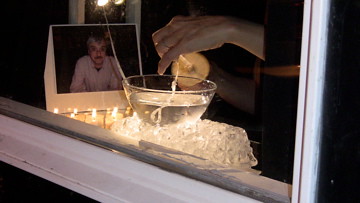
Photo: Cheyenne McCarter
I continue to work with an excerpt from Michel Serres' THE FIVE SENSES, contributed by Sarah Bliss, now fully transcribed and in a partial state of deconstruction through cutting and spinning into yarn.
This evening I struggled with issues around installing a low-hanging curtain and creating a new method related to the spinning. I was not able to settle into performance until 11:00 pm and was sorry to disappoint a few friends who came out on this warm summery night expecting to view something in the window. More time is needed in the space, I've decided. Many thanks to my friend and colleague Cheyenne McCarter who came by to shoot some video and stills.
Cheyenne's presence outside Mobius had an unexpected impact on my performance. She actively recruited passersby who noticed her with a tripod and camera pointing towards the window and engaged them in her interpretation of what Wrapped Intention is about. She talked about the piece in terms of sending healing energy out into the world and encouraged people to respond to the writing materials I'd placed underneath the mail slot. She even pursuaded a couple hurrying to the airport to tell her the name of someone who needed healing, which she offered to write for them on mulberry paper.
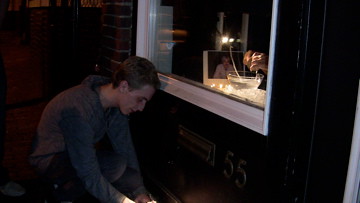
Photo: Cheyenne McCarter
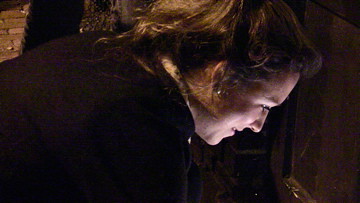
Photo: Cheyenne McCarter
This evening my task was to spin the second half of the Serres transcription into yarn. I had a drop spindle and a bowl filled with water (needed for spinning) resting on a bed of ice. The inspired use of block ice by Jeff and Sandy Huckleberry in their 'Color' performances - coupled with the sailor's account in Serres' text of the icy cold as he struggled to locate himself within and without his burning vessel - impelled me to add this material. The ice offered of itself an exquisite trickling sound as it slowly melted, in the quite stillness of my interior space, punctuated by the snippets of animated conversations outside. My focused spotlight glowed radiant inside this chilled pedestal, reflecting back onto my hands from the mirrors on which this assemblage rested.
I had wrapped the Serres text around a cardboard tube at the conclusion of my Seventh Week performance - morphed into one very long, continuous quarter-inch paper strip from a 24 x 36 inch formed sheet by an hour-long cutting action. The resulting object inspired me to hang the tube in the window this eighth week and engage it as a mechanism for feeding the strip downward - pulling it into the water with my left hand as my other hand fed it to my spindle, twirling in my fingers. Some friction caused by the tube encountering the low-hanging curtain (masking my face from the viewer and the viewer's face from mine) made it necessary to exercise the greatest care and patience when pulling, so as not to tear the fragile paper strip. My fingers became cold, shriveled, stiff.

Photo: Cheyenne McCarter
Eight candles were grouped by Bob's image. Fire and ice.

Photo: Cheyenne McCarter
After midnight I ended the performance, extinguished the candles and set about de-installing. As I worked I became aware of people stopping outside, talking quietly. They had taken notice of the un-cut, whole-form transcription of the first half of the Serres excerpt generated on the Sixth Week that I'd taped to the opposite window for passersby to read, backed by the dark curtains. I stilled myself and listened. They were a couple, male and female, taking turns reading aloud successive paragraphs of my hand-written transcription in a call and response fashion. I quietly took a seat on the other side of the window - my body tired and chilled - and secretly listened with gratitude for their choice in this moment to curiously observe and respond - creatively engaging with each other as a sailor's dramatic account unfolded in their slow performative recitation; a precious gift to this innocent voyeur.
When all became silent I was sure they'd left - but the clink of the mail slot a minute later added to my joy. I placed their contributions at the end of this blog entry.

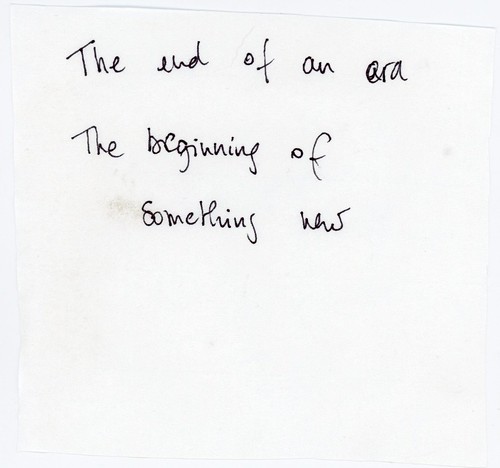
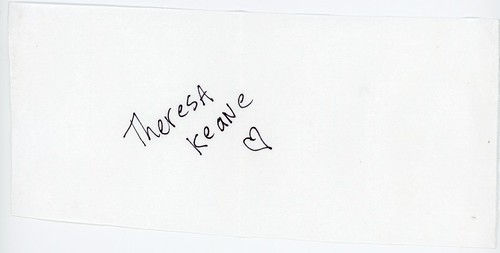
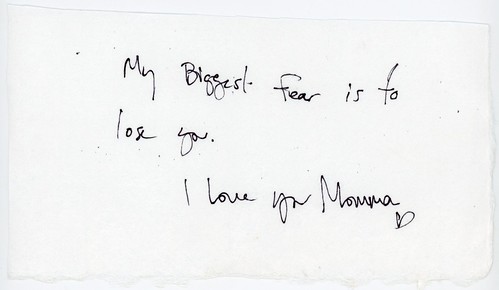
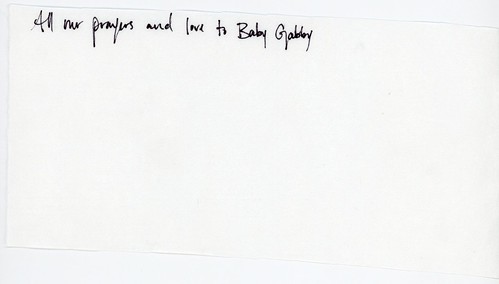
My final contributors of the evening used what paper was left (the mulberry had run out).
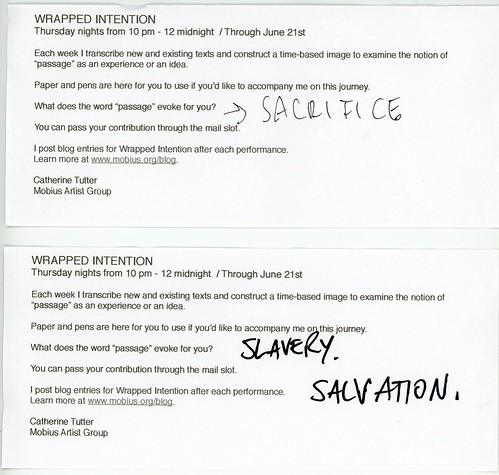

Photo: Cheyenne McCarter
I continue to work with an excerpt from Michel Serres' THE FIVE SENSES, contributed by Sarah Bliss, now fully transcribed and in a partial state of deconstruction through cutting and spinning into yarn.
This evening I struggled with issues around installing a low-hanging curtain and creating a new method related to the spinning. I was not able to settle into performance until 11:00 pm and was sorry to disappoint a few friends who came out on this warm summery night expecting to view something in the window. More time is needed in the space, I've decided. Many thanks to my friend and colleague Cheyenne McCarter who came by to shoot some video and stills.
Cheyenne's presence outside Mobius had an unexpected impact on my performance. She actively recruited passersby who noticed her with a tripod and camera pointing towards the window and engaged them in her interpretation of what Wrapped Intention is about. She talked about the piece in terms of sending healing energy out into the world and encouraged people to respond to the writing materials I'd placed underneath the mail slot. She even pursuaded a couple hurrying to the airport to tell her the name of someone who needed healing, which she offered to write for them on mulberry paper.

Photo: Cheyenne McCarter

Photo: Cheyenne McCarter
This evening my task was to spin the second half of the Serres transcription into yarn. I had a drop spindle and a bowl filled with water (needed for spinning) resting on a bed of ice. The inspired use of block ice by Jeff and Sandy Huckleberry in their 'Color' performances - coupled with the sailor's account in Serres' text of the icy cold as he struggled to locate himself within and without his burning vessel - impelled me to add this material. The ice offered of itself an exquisite trickling sound as it slowly melted, in the quite stillness of my interior space, punctuated by the snippets of animated conversations outside. My focused spotlight glowed radiant inside this chilled pedestal, reflecting back onto my hands from the mirrors on which this assemblage rested.
I had wrapped the Serres text around a cardboard tube at the conclusion of my Seventh Week performance - morphed into one very long, continuous quarter-inch paper strip from a 24 x 36 inch formed sheet by an hour-long cutting action. The resulting object inspired me to hang the tube in the window this eighth week and engage it as a mechanism for feeding the strip downward - pulling it into the water with my left hand as my other hand fed it to my spindle, twirling in my fingers. Some friction caused by the tube encountering the low-hanging curtain (masking my face from the viewer and the viewer's face from mine) made it necessary to exercise the greatest care and patience when pulling, so as not to tear the fragile paper strip. My fingers became cold, shriveled, stiff.

Photo: Cheyenne McCarter
Eight candles were grouped by Bob's image. Fire and ice.

Photo: Cheyenne McCarter
After midnight I ended the performance, extinguished the candles and set about de-installing. As I worked I became aware of people stopping outside, talking quietly. They had taken notice of the un-cut, whole-form transcription of the first half of the Serres excerpt generated on the Sixth Week that I'd taped to the opposite window for passersby to read, backed by the dark curtains. I stilled myself and listened. They were a couple, male and female, taking turns reading aloud successive paragraphs of my hand-written transcription in a call and response fashion. I quietly took a seat on the other side of the window - my body tired and chilled - and secretly listened with gratitude for their choice in this moment to curiously observe and respond - creatively engaging with each other as a sailor's dramatic account unfolded in their slow performative recitation; a precious gift to this innocent voyeur.
When all became silent I was sure they'd left - but the clink of the mail slot a minute later added to my joy. I placed their contributions at the end of this blog entry.





My final contributors of the evening used what paper was left (the mulberry had run out).

Wrapped Intention: Seventh Week : Catherine Tutter
Sun Mar 25, 2012
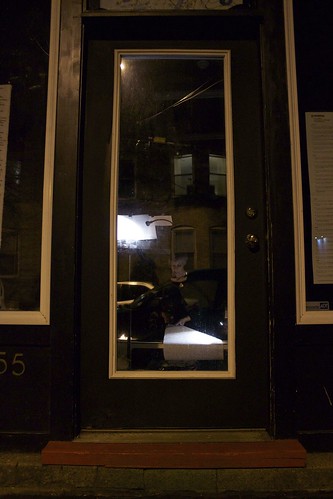
Photo: Dennis Friedler
Dedicated to the memory of Bob Raymond
Many thanks to Sarah Bliss for her contribution of my transcription text by Michel Serres, which passed through the mail slot at 55 Norfolk Street via postal delivery.
I transcribed the remaining portion of Serres' text and used large, heavy scissors to cut the paper. The work was slow, methodical. I was curious to see how it would feel taking a spot closer to the interior of the space, set back a couple of feet from the front door. I thought a lot about the doorway as an enduring symbol of passage, marked as it is in many cultures as such. A young couple sat for a while on the wooden bench I put out by the curb, conversing socially, enjoying their evening out - enshrined by the door. Before leaving, each responded to my invitation to write about passage.
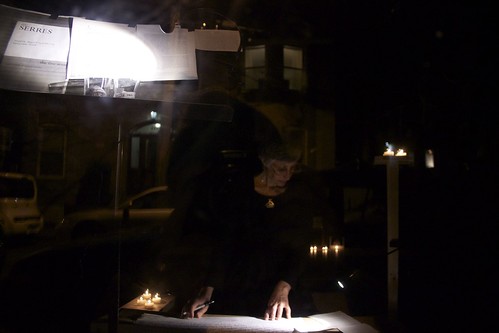
Photo: Dennis Friedler
Continued from Sixth Week, the remaining transcription of THE FIVE SENSES, a Philosophy of Mingled Bodies by Michel Serres
Translated by Margaret Sankey & Peter Cowley
Chapter 1-Veils
(BIRTH)
…Then a big wave, coming suddenly from the side, violently jolts the neckpiece towards my suspended ribs. God be praised, I am out. I breathe the cold air and almost faint. To my horror, the sea, still more relentless, hammers randomly at the bottom of the boat which tilts over on to the other side and I am inside again, rammed again into the iron circle under my chest. It felt as though the hull were passing over piles of stones. A shock on the one side freed me; a shock from the other side imprisoned me again.
I was inside, I was outside.
Who was this “I”?

Photo: Dennis Friedler
It is something everyone knows, unemotionally and as a matter of fact. You only have to pass through a small opening, a blocked corridor, swing over a handrail or on a balcony high enough to provoke vertigo for the body to become alert. The body knows by itself how to say I. It knows to what extent I am on this side of the bar, and when I am outside. It judges deviations from normal balance, immediately regulates them and knows just how far to go, or not go. Coenesthesia says I by itself. It knows that I am inside, it knows when I am freeing myself. This internal self proclaims, calls, announces, sometimes howls the I like a wounded animal. This common sense apportions the body better than anything else in the whole world.
If I slide a leg through, I am still inside, while my leg, thigh and knee are outside. They become almost black. My pelvis goes through, my genitals, buttocks and navel are most certainly outside but I remain inside. I know what it is like to be a man without legs; I know for a moment what phantom limbs feel like. At a precise moment, the very moment when the totality of the divided body shouts ego in a general toppling movement, I slide out and can drag through the remainder of my body, pull through the pieces that have remained inside, yes, the scattered pieces that have suddenly been blackened in the violent overturning of the iceberg.
 Photo: Dennis Friedler
Photo: Dennis Friedler
The random jolting of the vessel as it heaves to throw the I to the left and right of the window of hope. I dwell inside, I dwell outside; the I inside the boat finds itself outside, in the icy gusts of wind. The movement of the waves pushes or pulls the thorax a few millimetres in either direction, a tiny distance. My body is aware of this deviation; it is able to appreciate the movements around it. I am delivered or debarred, breathing or asphyxiated, burning from the fire inside or stripped bare by the biting wind, dead or alive. I go under or I exist. There is an almost identifiable point which, in the spatial experience of passing from inside to out, is proclaimed by the whole body. The I as a whole leaps towards this localized point and moves decisively from on half of the body to the other when the point slides, in contact with the separating wall, from its internal to its external surface.
Since my near shipwreck I have become accustomed to calling this point the soul. The soul resides at the point where the I is decided.
We are all endowed with a soul, from that first moment of passage when we risked and saved our existence.
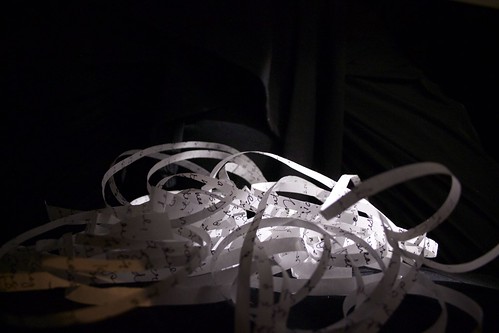 Photo: Dennis Friedler
Photo: Dennis Friedler
I understood that evening the meaning of the cry: save our souls. Saving this point is enough. I found myself outside, in the horrifying cold, when the point passed the threshold of the restraining collar. I was still inside until that moment. Descartes is right to say that the soul touches the body at a particular point, but he was wrong to locate it in the pineal gland. It hovers around the region of the solar plexus. From there it illuminates or obscures the body, in bursts of light or dark, making it translucid or epiphanic, transmuting it into a black body. It is somewhere in that area for everyone, according to the dictates of each individual’s body. We all retain it, marked and definitive, where it was fixed on the day we were born. More often than not, it is forgotten and left in the shadows of internal meaning, until the day when the sudden fury of nature causes us to be born a second time, through chance, pain, anguish or luck. It is not such a bad thing, pace Descartes, that on that youthful day, piloting a ship, we were to discover that a pilot says I for his whole vessel, from the depths of the keel to the tip of the mast, and from the quarter to the boom, and that the soul of his body descends into the soul of the boat, towards the central turbines, to the heart of the quickworks. To free yourself from that vessel, you have to search for your soul in the hold, where the fire is at its most dangerous – one perilous day.

Photo: Dennis Friedler
Contributions passed through the mail slot:
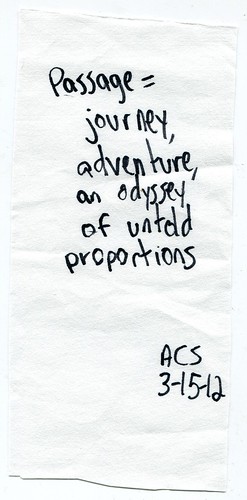
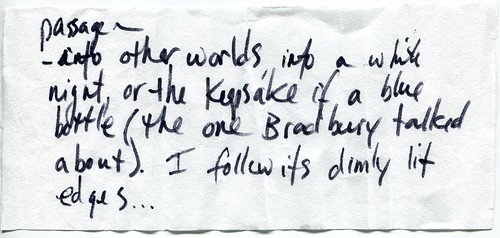

Photo: Dennis Friedler
Dedicated to the memory of Bob Raymond
Many thanks to Sarah Bliss for her contribution of my transcription text by Michel Serres, which passed through the mail slot at 55 Norfolk Street via postal delivery.
I transcribed the remaining portion of Serres' text and used large, heavy scissors to cut the paper. The work was slow, methodical. I was curious to see how it would feel taking a spot closer to the interior of the space, set back a couple of feet from the front door. I thought a lot about the doorway as an enduring symbol of passage, marked as it is in many cultures as such. A young couple sat for a while on the wooden bench I put out by the curb, conversing socially, enjoying their evening out - enshrined by the door. Before leaving, each responded to my invitation to write about passage.

Photo: Dennis Friedler
Continued from Sixth Week, the remaining transcription of THE FIVE SENSES, a Philosophy of Mingled Bodies by Michel Serres
Translated by Margaret Sankey & Peter Cowley
Chapter 1-Veils
(BIRTH)
…Then a big wave, coming suddenly from the side, violently jolts the neckpiece towards my suspended ribs. God be praised, I am out. I breathe the cold air and almost faint. To my horror, the sea, still more relentless, hammers randomly at the bottom of the boat which tilts over on to the other side and I am inside again, rammed again into the iron circle under my chest. It felt as though the hull were passing over piles of stones. A shock on the one side freed me; a shock from the other side imprisoned me again.
I was inside, I was outside.
Who was this “I”?

Photo: Dennis Friedler
It is something everyone knows, unemotionally and as a matter of fact. You only have to pass through a small opening, a blocked corridor, swing over a handrail or on a balcony high enough to provoke vertigo for the body to become alert. The body knows by itself how to say I. It knows to what extent I am on this side of the bar, and when I am outside. It judges deviations from normal balance, immediately regulates them and knows just how far to go, or not go. Coenesthesia says I by itself. It knows that I am inside, it knows when I am freeing myself. This internal self proclaims, calls, announces, sometimes howls the I like a wounded animal. This common sense apportions the body better than anything else in the whole world.
If I slide a leg through, I am still inside, while my leg, thigh and knee are outside. They become almost black. My pelvis goes through, my genitals, buttocks and navel are most certainly outside but I remain inside. I know what it is like to be a man without legs; I know for a moment what phantom limbs feel like. At a precise moment, the very moment when the totality of the divided body shouts ego in a general toppling movement, I slide out and can drag through the remainder of my body, pull through the pieces that have remained inside, yes, the scattered pieces that have suddenly been blackened in the violent overturning of the iceberg.
 Photo: Dennis Friedler
Photo: Dennis FriedlerThe random jolting of the vessel as it heaves to throw the I to the left and right of the window of hope. I dwell inside, I dwell outside; the I inside the boat finds itself outside, in the icy gusts of wind. The movement of the waves pushes or pulls the thorax a few millimetres in either direction, a tiny distance. My body is aware of this deviation; it is able to appreciate the movements around it. I am delivered or debarred, breathing or asphyxiated, burning from the fire inside or stripped bare by the biting wind, dead or alive. I go under or I exist. There is an almost identifiable point which, in the spatial experience of passing from inside to out, is proclaimed by the whole body. The I as a whole leaps towards this localized point and moves decisively from on half of the body to the other when the point slides, in contact with the separating wall, from its internal to its external surface.
Since my near shipwreck I have become accustomed to calling this point the soul. The soul resides at the point where the I is decided.
We are all endowed with a soul, from that first moment of passage when we risked and saved our existence.
 Photo: Dennis Friedler
Photo: Dennis FriedlerI understood that evening the meaning of the cry: save our souls. Saving this point is enough. I found myself outside, in the horrifying cold, when the point passed the threshold of the restraining collar. I was still inside until that moment. Descartes is right to say that the soul touches the body at a particular point, but he was wrong to locate it in the pineal gland. It hovers around the region of the solar plexus. From there it illuminates or obscures the body, in bursts of light or dark, making it translucid or epiphanic, transmuting it into a black body. It is somewhere in that area for everyone, according to the dictates of each individual’s body. We all retain it, marked and definitive, where it was fixed on the day we were born. More often than not, it is forgotten and left in the shadows of internal meaning, until the day when the sudden fury of nature causes us to be born a second time, through chance, pain, anguish or luck. It is not such a bad thing, pace Descartes, that on that youthful day, piloting a ship, we were to discover that a pilot says I for his whole vessel, from the depths of the keel to the tip of the mast, and from the quarter to the boom, and that the soul of his body descends into the soul of the boat, towards the central turbines, to the heart of the quickworks. To free yourself from that vessel, you have to search for your soul in the hold, where the fire is at its most dangerous – one perilous day.

Photo: Dennis Friedler
Contributions passed through the mail slot:


Subscribe to:
Posts (Atom)

i give you a thumbs up as